
The
Human
Passions
Werner Adriaenssens
André Demesmaeker
Claudine Houbart



Keen to promote the wealth and variety of the heritage of the Brussels-Capital Region, Urban aims, through the Brussels, City of Art and History collection, to stimulate the public's curiosity about the history of the city and to raise awareness about protecting its constituent masterpieces.
Designed by Victor Horta, the Pavilion of Human Passions is a hidden gem of the Parc du Cinquantenaire/Jubelpark. The small, classically-inspired temple houses a magnificent marble relief by Jef Lambeaux, after which the pavilion is named. Together, they are the product of a unique but tumultuous collaboration between two masters of Belgian sculpture and architecture.
The Human Passions provoked controversy from the outset. After it opened in 1910, the pavilion was relegated to the background and fell into obscurity for many years. At one point, the building – and its contents – seemed destined for the same fate as some of Horta's other works. However, in the late 20th century the work was saved from irreversible transformations. A successful restoration carried out between 2012 and 2014 means that the pavilion and the relief can now be enjoyed in all their glory once again.
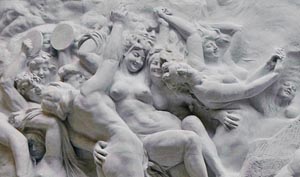
“Never, perhaps, has a sculptural work been talked about like this one – from the day the artist conceived it and in the ensuing period when it seemed as if it would be impossible to realise, its execution appeared to fall within the realm of imagination and enchantment.” These are the touching words of the art critic Lucien Solvay, who himself played a prominent role in this story. The Human Passions has had a remarkable history. By 1897, when Solvay wrote those words, the work had already experienced many twists and turns. But that was just the beginning.
The protagonists in this saga are the sculptor Jef Lambeaux and the architect Victor Horta. The former was to produce the most significant work of his life with The Human Passions, while the latter fulfilled his first state commission by designing the pavilion to house the relief. In all, it would take just over 120 years before all the problems were resolved and the artwork could finally be admired by the public.
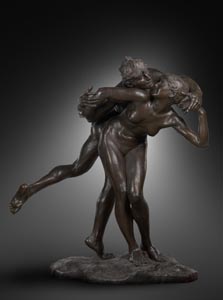
Jef Lambeaux’s great breakthrough as an artist came in the 1880s. The Antwerp-born sculptor settled permanently in Brussels in 1881, the year in which he achieved his first success at the Brussels Salon (an exhibition of the works of living artists) with his sculptural group The Kiss. Depicting two moving nude figures in a Mannerist style, the piece had been seen as both daring and compelling. The resulting controversy had raised the sculptor’s profile, and the work was purchased by the Royal Museum of Fine Arts in Antwerp. In 1882, Lambeaux received a subsidy from the Belgian State and Antwerp Municipal Council, which he used to travel to Italy to study 16th- and 17th-century sculpture. This experience had a lasting impact on his work. The Brabo Fountain, a work imbued with the ardour of Giambologna, is the first and most striking example of this influence. Lambeaux exhibited the maquette, comprising a moving figure on a turbulent base, at the Ghent Salon in 1883. The work was a huge success with the public and made the sculptor very famous. The fountain was commissioned by Antwerp Municipal Council in 1884 and inaugurated on the city’s Grote Markt (Great Market Square) in 1887.
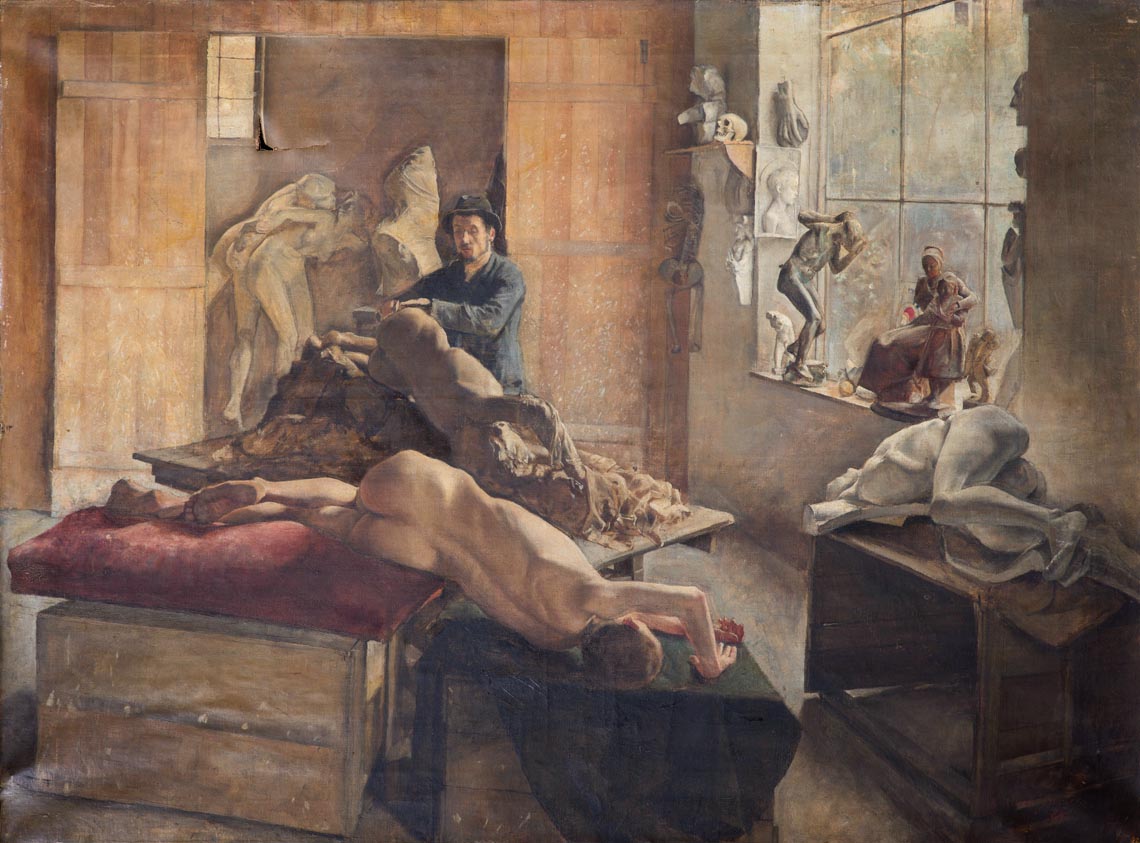
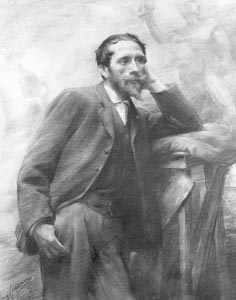
One of the leading sculptors of the 19th century, Jef Lambeaux was born in Antwerp in 1852 and died in Brussels in 1908. Born into a family of artists, he studied at the Antwerp Royal Academy of Fine Arts from an early age. Though a brilliant student, he missed out on winning the prestigious Prix de Rome scholarship. From 1873, he began submitting works for exhibitions at the Antwerp, Brussels, Ghent and Paris Salons. He lived in Paris from the late 1870s, returning to Belgium in 1881. It was then that he made his breakthrough as an artist.
After receiving a scholarship to travel to Italy, Lambeaux became widely known and was awarded official commissions such as the Brabo Fountain, The Human Passions and La Folle Chanson (The Crazy Song).
Such was his success that he was certainly the most reproduced artist of his time. Plaster and bronze reproductions of Lambeaux’s sculptures went on being sold and remained a fixture in the homes of the bourgeoisie until long after his death.
Designing and creating The Human Passions took up a large part of his career. Despite the difficulties encountered, it was to become his best-known and most controversial work.
The inauguration of the Brabo Fountain in August 1887 was a major triumph for Jef Lambeaux, but he was not one to rest on his laurels. His attention was soon directed elsewhere, as revealed by an article in the journal La Fédération artistique in November 1886, in which art critic Georges Verdavaine noted that the sculptor was hard at work on “some gigantic project” – a colossal relief representing humanity in all its passions. Lambeaux’s new enterprise was also reported by the newspaper Journal de Bruxelles in February 1887, which described it as the sketch for a teeming, vibrant bas-relief of which only the main features and play of light could be seen so far. The sculptor had told the journalist that it was to be his life’s work. The paper immediately hailed it as a “masterpiece in the making”.
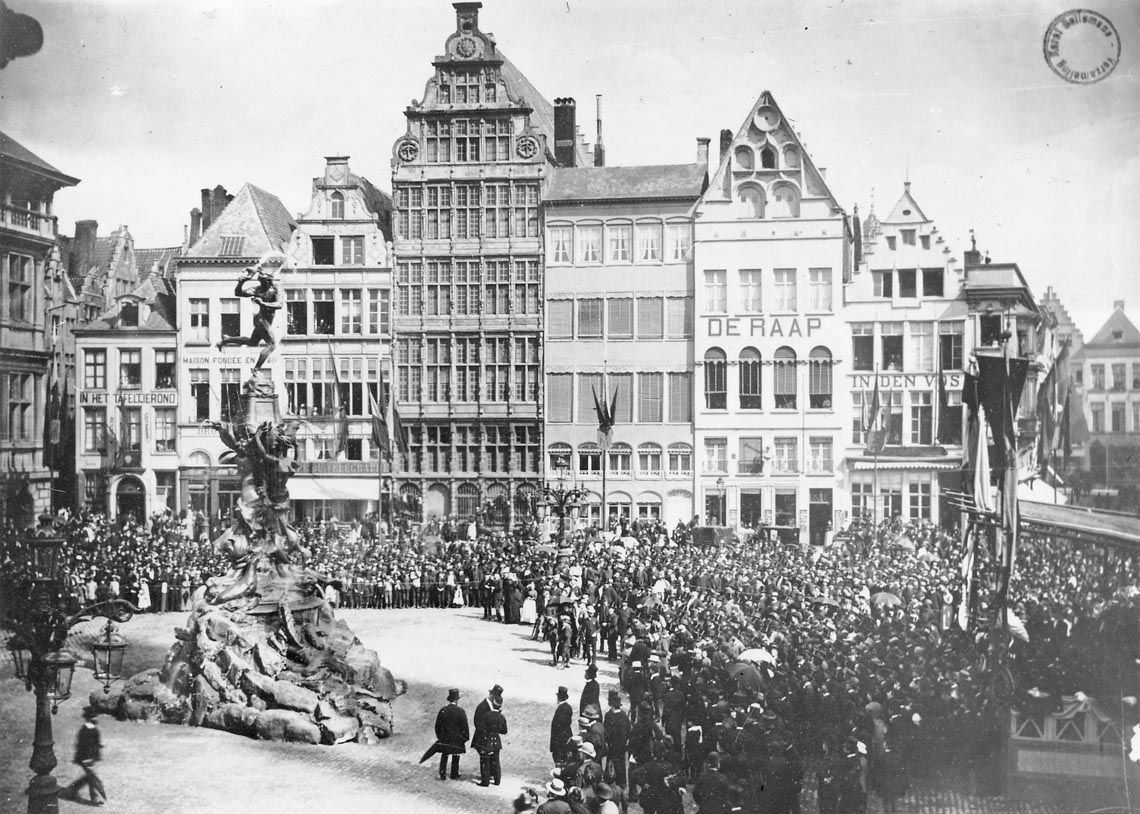
Over a year and a half later, on 12 August 1888, Lambeaux himself reported on the work. In a letter to his friend, the art critic Max Sulzberger, he asked if Sulzberger would do him the favour of coming over to admire the drawing, although he wanted to do some more work on it first so that he could show it off in its full glory and Sulzberger could give a “meaningful appraisal”.
From late 1886 to April 1889, Lambeaux hid himself away as he worked on the drawing with great enthusiasm. No one was allowed into his studio, and anyone who did gain access was confronted with a green curtain covering the entire wall and shielding the immense sketch from prying eyes...

Three years later, in April 1889, the drawing was just about complete. For Lambeaux, this was the perfect moment to reopen his studio in Saint-Gilles and proudly unveil the bas-relief design. Journal de Bruxelles reported that Lambeaux’s studio was very busy at this time: “His studio has reopened to visitors, artists and friends, and for the past eight days there has been a constant stream of callers.” These were mostly close intimates invited by the artist. His friend, the sculptor Thomas Vinçotte, is said to have come three times in the space of two days. Painter and sculptor Jacques de Lalaing apparently stayed for half a day, gazing awestruck at the work, and the painter Euphrosine Beernaert was also among the guests. As well as artists, Lambeaux invited a number of art critics he also knew personally. This was to prove a huge mistake, and one that would sully the perception of the drawing.
Max Sulzberger was the first of the art critics to come and view the work. He published an account of the visit in the newspaper L’Étoile belge on 11 April 1889. Together with an article in La Réforme, this was the first in a long series of reports about the monumental relief published that year.
Sulzberger’s piece expressed great appreciation of the work generally, and in particular its “brilliant” composition. Referring to it as La Passion de l’Humanité (The Passion of Humanity), he compared it with the “immortal” creations of Hellenistic art and threw in allusions to such greats as Michelangelo, Rubens and Jordaens, while stressing that Lambeaux’s work was a highly distinctive and personal achievement.
An extraordinarily effusive review of the drawing, headed Un Chef-d’œuvre (A Masterpiece), appeared that same year in the daily newspaper La Réforme. The journalist, writing under the name Champal, entitled the work Les Passions humaines conduisant à la mort (The Human Passions Leading to Death). The plastic composition was, he felt, worthy of the most prodigious flights of the Renaissance: “Not since the ‘mighty Michelangelo’ has anything comparable been conceived in the history of art anywhere in the world.” He refrained from comparing the work with that of Antoine Wiertz, judging such a comparison misplaced: there was a vast difference between Lambeaux’s output and the, to his mind, “inferior” works of the Belgian painter and sculptor, whose heyday had been in the mid-19th century. For Champal, Lambeaux’s creation was a philosophical work in which each character had a meaning.
Further highly complimentary reviews followed in Journal de Bruxelles and La Fédération artistique, their authors equally rapturous about the drawing. There could be no doubt about it: Jef Lambeaux was the only artist in Europe capable of creating such a piece.
The drawing of The Human Passions is now kept at the Royal Museum of Fine Arts Antwerp. The charcoal on canvas design measures 6.10 x 10.90 m, almost as large as the marble relief it gave rise to.
In French it is known as a carton, a technical term meaning a real-size draft version of a work of art. Jef Lambeaux often referred to his carton in letters, and the press at the time also used the term. However, this was to result in some confusion later on: since the primary meaning of carton is ‘cardboard’, it was thought that Lambeaux had drawn the design for The Human Passions on cardboard.
It is not unusual for a sculptor to produce a draft version of a sculpture. Some make a bozzetto, a small-scale preparatory model, while others draw sketches or do both. We know that Jef Lambeaux often made drawings, and sometimes paintings too. In a description of his studio that appeared in Journal de Bruxelles in 1889, the journalist noted that all the walls were covered with drawings. This is confirmed by later testimonies and by a photo of Lambeaux’s studio showing the sculptor with his drawings visible on the wall behind him. It is no surprise then, given the scale of the project, that Lambeaux should have spent several years working on the carton.

It is not known if the sculptor first produced a bozzetto. According to Lucien Solvay in 1897, he had made a “quick sketch” of the work 10 years earlier, but it is impossible to know if this was a drawing or a model.
The drawing of The Human Passions was purchased in 1890 for the decorative painting collections of the Royal Museums of Decorative and Industrial Art (the present Royal Museums of Art and History) in Brussels.
On 15 May 1889, the art critic Lucien Solvay published an account of the Paris World’s Fair in the newspaper Le Soir. In the Fine Arts section of the exhibition, Belgian sculpture was represented by, among others, Charles van der Stappen, Paul De Vigne and Constantin Meunier. According to Solvay, Jef Lambeaux was conspicuous by his absence. “Did he think it would be beneath his dignity to exhibit alongside the rest, and that he would not be appreciated unless he had a special room to himself?” he asked, waspishly. “He was wrong. His absence will indeed be a matter of regret – but chiefly to himself.”
Lambeaux had in fact intended to unveil the drawing of his monumental relief at the Paris World’s Fair in 1889, but for some reason did not do so, probably because it was not ready.
In the end, the drawing was first presented to the public at the triennial Ghent Salon between 11 August and 6 October 1889, under the title L’Humanité (Humanity). Given the glowing press reports in the preceding period, expectations were high.
Many newspapers reported on the Salon as soon as it opened, with Lambeaux’s carton garnering much attention. Champal, writing in La Réforme, even suggested that “the Ghent exhibition appears to have been arranged so as to allow the great artist to display his vast composition in public”. He noted that the sculptor had been given a wonderful space of his own in which to show off the drawing with suitable lighting.
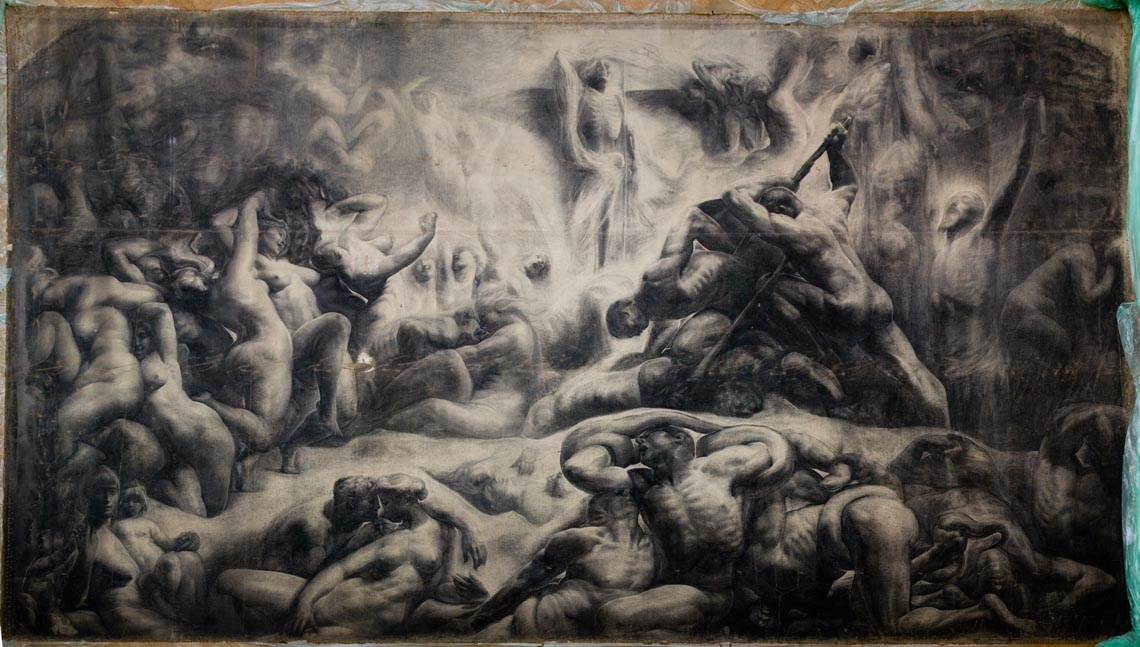
Lucien Solvay opened the series of discussions on the work in Le Soir on 15 August, devoting almost an entire article to it. So much had been said about it already, he wrote, but apart from a few “insiders”, no one had actually seen it. While he considered it to be the leading work at the Salon, he was not overly enthusiastic about its merits. In his analysis, he highlighted three stumbling blocks which, between them, summarise the whole controversy surrounding the work: the lack of substance and coherence in the composition and the fact that it had been hailed as a masterpiece.
In Solvay’s view, Humanity was simply a pompous pretext to bring together different groups of subjects, and there was no point looking for anything more in it: “We know [Lambeaux] well enough to be sure that, regardless of what we may have been led to believe, the ambition to be a philosopher has never entered his head.” At first glance, he found the composition remarkable, with its particularly successful play of shadow and light and pretty Rubenesque lines that helped to create a feeling of movement. As such, Solvay accorded the work great decorative value. But on closer inspection, he felt that the quality which usually characterised Lambeaux’s work was missing. In particular, there were a large number of technical mistakes: a crowd of disjointed figures with legs in problematic positions and heads strangely attached to shoulders. Solvay believed that the sculptor should rework the whole design, as a faithful execution in marble would only make the errors more apparent. The following remark is particularly telling in this regard: “This drawing was presented to us with all the fanfare that accompanies a masterpiece, hallowed and consecrated before it had even seen the light of day. There has perhaps been some exaggeration. We feel sorry for the artist, to whom a great disservice has been done by being flattered in this way.” Solvay’s remarks were a slap in the face for those close friends of Lambeaux who had seen the work in his studio and praised it to the skies.
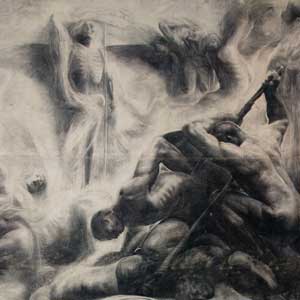
A letter to Max Sulzberger shows that this article touched a raw nerve with Jef Lambeaux. Expressing his annoyance, the sculptor said he was sure that Solvay’s withering critique had nothing to do with the work itself. Solvay had set out to portray him in a bad light, just as he had done previously with the painter Franz Courtens. Sulzberger subsequently published another article in L’Étoile belge lavishing praise on the work and reaffirming his view that it was a masterpiece. Champal too devoted another full article in La Réforme to what he called the “irresistible work”, “the most grandiose chorus of human splendour imaginable”.
Despite the repetition of these positive reviews, Solvay’s article had divided the press into two camps of staunch supporters and detractors. The former considered the work a masterpiece, while the latter judged it to be devoid of substance, with some even decrying it as pure charlatanism.
Safe to say, a great deal of ink was spilled on the subject in that summer of 1889. “In a word, Jef Lambeaux forever” wrote the newspaper Het Handelsblad, with a hint of irony …
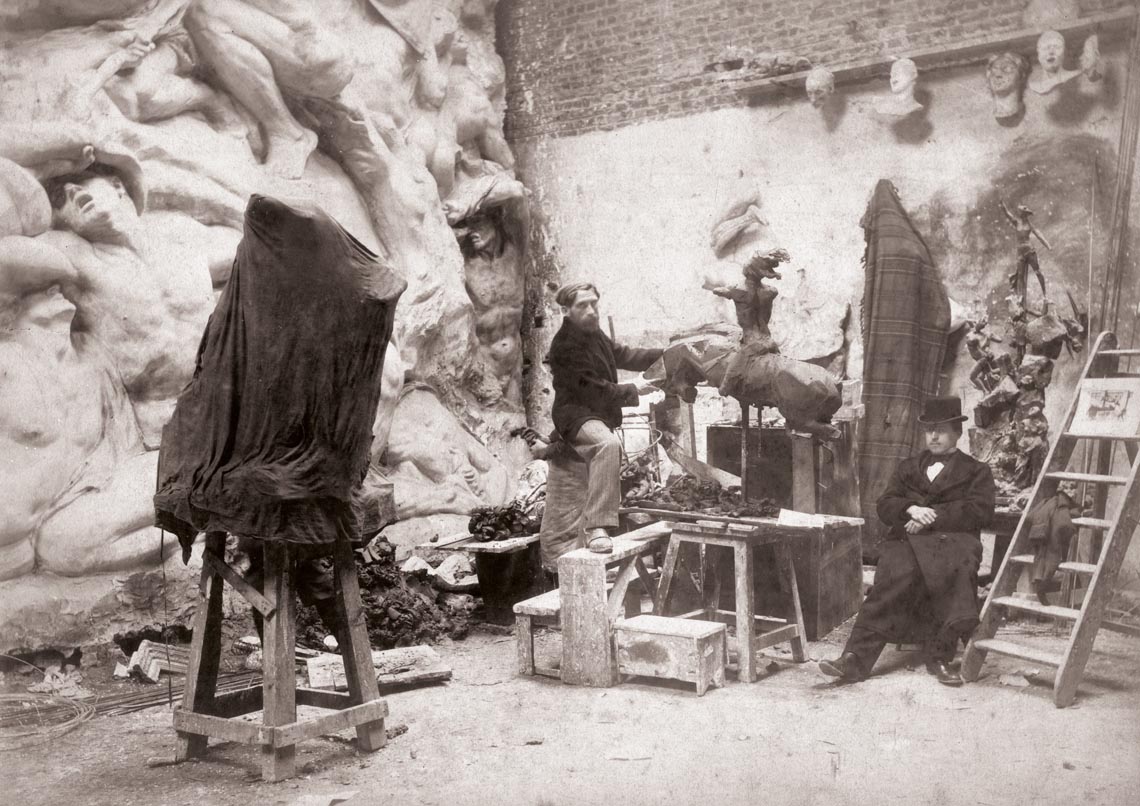
One of the main questions raised by these criticisms was what Jef Lambeaux was (or was not) trying to say in this monumental work. In an article dated 22 August 1889, a journalist at Het Handelsblad made no secret of the mountain of incomprehension that the work had encountered: “The artist aspires to put down on paper a philosophical idea: very well, let this good man explain to us what this entanglement of heads, legs and arms, of biting and dancing, of blows and claws, of flying and crawling bodies means. What Christ on the cross is doing amidst all this depravity remains a mystery: and we are truly at a loss as to the significance of the figures entwined with snakes. There is undeniably talent in the way it is all executed, no one is disputing that; but to call it a work of genius … pull the other one!”
It is astonishing that the sculptor himself never gave the slightest explanation about what exactly he intended to express. He left this discussion to the press, without ever getting involved directly. It is even more remarkable that Lambeaux did not come up with the sculpture’s title The Human Passions. Instead, proposals were put forward by art-critic friends, with the artist’s approval.
When Georges Verdavaine first reported on Lambeaux’s mammoth project in 1886, he described it as depicting “humanity erupting with its passions”. This was also the sculptor’s basic idea. Verdavaine had seen the drawing in Lambeaux’s studio in April 1889 and gave a lengthy account of it in an article entitled Les Passions humaines (The Human Passions). Also in April 1889, Champal described it in a fulsome article in La Réforme under the heading Les Passions humaines conduisant à la mort (The Human Passions Leading to Death).
At the Ghent Salon, the work was exhibited under the title L’Humanité (Humanity), a name which art critic Lucien Solvay found pompous and lacking in meaning.
When the plaster model of the sculpture was completed in 1894 and was ready to be shown to the public, the magazine La Fédération artistique called it La Passion de l’Humanité (The Passion of Humanity). In his article in L’Étoile belge on 7 November 1894, Max Sulzberger gave it the name Le Calvaire de l’Humanité (The Calvary of Humanity). On the same day, Lambeaux wrote to Sulzberger telling him that he agreed with this title and that Champal, who himself had dubbed the work L’Inanité des Passions Humaines (The Inanity of Human Passions), found Sulzberger’s suggestion much better. He added that the Prime Minister himself, Auguste Beernaert, also thought it a fitting name. Despite this, the title of the work was subsequently changed again for some unknown reason, reverting to the original name of The Human Passions. This was the title placed above the door of the pavilion when it was completed in 1910.

The leading Belgian art magazine L’Art moderne had largely kept out of the whole discussion, devoting only one paragraph to it in its articles on the Ghent Salon. But the journalist in question was clearly far from convinced: “For all the cries of ‘masterpiece’ in the press, and all the trumpeting of its allegorical power, the allegory is dominated by death, just as nothingness dominates the work itself.”
An article published in the same magazine on 6 October 1889 under the title Camaraderie artistique (Artistic Camaraderie) was of an altogether different nature. Its effect was explosive. In fact, Jef Lambeaux’s drawing was merely a pretext for L’Art moderne to launch a personal, virulent and unprecedented attack on the art critic Champal. According to the author of the article, Champal was guilty of exalting works of art that were essentially mediocre. He even coined a new verb for this: champaliser.
By writing favourable articles, the journalist claimed, Champal was seeking to build relationships in order to exert influence and derive personal benefit. L’Art moderne went so far as to suggest that the close friendship (the “camaraderie” of the title) between Champal and artists might have led to him accepting artworks in exchange for articles, publicity, lectures and so on.
In this context, Lambeaux’s drawing was cited as the most recent example of champalisation. After all, Champal had been among the first to have a preview of the drawing in the sculptor’s studio, and then to shower it with superlatives in the pages of La Réforme – a fact that L’Art moderne did not fail to emphasise, before noting once again that, in reality, the work fell far short of expectations. By way of a killer blow, it even described it as “striking the eye but not the soul”. In this article, L’Art moderne not only accused Champal of wrongdoing but publicly questioned his competence as an art critic.
Clearly, Champal had no choice but to respond to this personal attack. In a right of reply entitled Stupendum! (Stupendous!) published in the following issue of L’Art moderne, he railed against what he termed pathetic insinuations and slurs, and stated in his defence that he had never received a single artwork or dinner invitation from the artists he had written about. But he went further than this, turning everything on its head by claiming that the problem lay with L’Art moderne, not with him. He accused the magazine of bullying the press when it reported favourably on artists outside its circle.
The truth was that Jef Lambeaux’s drawing had been an excuse to settle an old score between the editors of L’Art moderne and Champal. Champal was the pseudonym of Achille Chainaye, a sculptor who in 1883 had become a member of the avant-garde artistic circle Les XX (The Twenty). From 1884 to 1886, he exhibited his work in their annual shows, but his relations with the group soured in 1884 when the Godecharle Prize was awarded to the sculptor Paul Du Bois, a founding member of Les XX. Disappointed that his career as a sculptor was failing to take off and driven by financial necessity, in 1886 Chainaye began writing under the pseudonym Champal. Three years later, in 1889, when Lambeaux unveiled his drawing, Chainaye withdrew from Les XX, unhappy with the turn of events.
It was no coincidence that the article Camaraderie artistique appeared in L’Art moderne since this magazine was the mouthpiece for Les XX. Lawyer and writer Octave Maus, a leading figure in the circle, had been one of the founders of the periodical and was on its editorial staff. Jef Lambeaux had also become a member of Les XX in 1883, but withdrew in 1884 after the first exhibition. His departure may have been prompted by an aversion to its ideological framework and the avant-garde vision of Les XX. Lambeaux was also a close friend of Achille Chainaye, but for L’Art moderne, Lambeaux’s drawing was primarily a pretext to settle old scores with Chainaye. This goes a long way towards explaining Chainaye’s response, in which he accused L’Art moderne of lording it over the art world like a pope, making and breaking reputations.
The article made a big splash and Lambeaux’s drawing found itself in the spotlight. A few days after its publication in L’Art moderne, Lucien Solvay penned another long article in Le Soir under the same title, Camaraderie artistique, in which he fully endorsed what L’Art moderne had written and praised its editors for their courage in publishing it. He also shared his own experience, describing how he had been the target of a “chorus of insults” following his critical review of the drawing in Le Soir.
Journal de Bruxelles, on the other hand, which had defended the drawing from the outset, felt that L’Art moderne had overstepped the mark. Its journalist highlighted the risk that such an article posed: “L’Art moderne’s lambasting of Achille Chainaye, and by implication virtually all other critics, means that in future no one will be able to bestow praise that goes against the predilections of L’Art moderne without being accused of dishonest motives.” He added that it was surprising that such a text had been published in L’Art moderne of all places, given the very important role played by “camaraderie” in that magazine. Finally, he alluded subtly to the fact that both Achille Chainaye and Jef Lambeaux had once been members of Les XX but had both left, which they were perfectly entitled to do ...
The dispute also made waves in other publications. Het Handelsblad, for example, expressed its irritation at “coteries partaking in a spirit of partisanship by hailing works as masterpieces provided that they are by friends of their particular clique.” Jan-Matthijs Brans, who had written a positive review of the Lambeaux drawing in the art and literature journal De Vlaamse School, felt it necessary to distance himself from the article in L’Art moderne. And years later, in 1897, Jean Delville made a sarcastic reference to the incident in the postscript to a negative article on the Lambeaux work that he wrote for the magazine L’Art idéaliste: “The signatory of this article formally declares that he has not yielded to any feelings of personal hatred and that the vehemence of his words is solely attributable to his forthright views as an artist, which are underpinned by the aesthetic principles that he holds dear and that guide his actions.”
As soon as Lambeaux unveiled his drawing of The Human Passions, comparisons were made with the works of Michelangelo, Peter Paul Rubens and Antoine Wiertz. Champal even went so far as to say that “not since Michelangelo has anything comparable been conceived in the history of art anywhere in the world.” The muscular bodies of the men, the voluptuous women and the diagonal composition give the work a similar feel to that of Rubens. There are also allusions to the romantic painter Antoine Wiertz in both the composition and the format. This is not surprising as Lambeaux was interested in Wiertz’s work. Indeed, in February 1888, while he was working on the drawing, the City of Dinant commissioned him to produce a three-dimensional version of Wiertz’s monumental work Le Triomphe de la Lumière (The Triumph of Light).
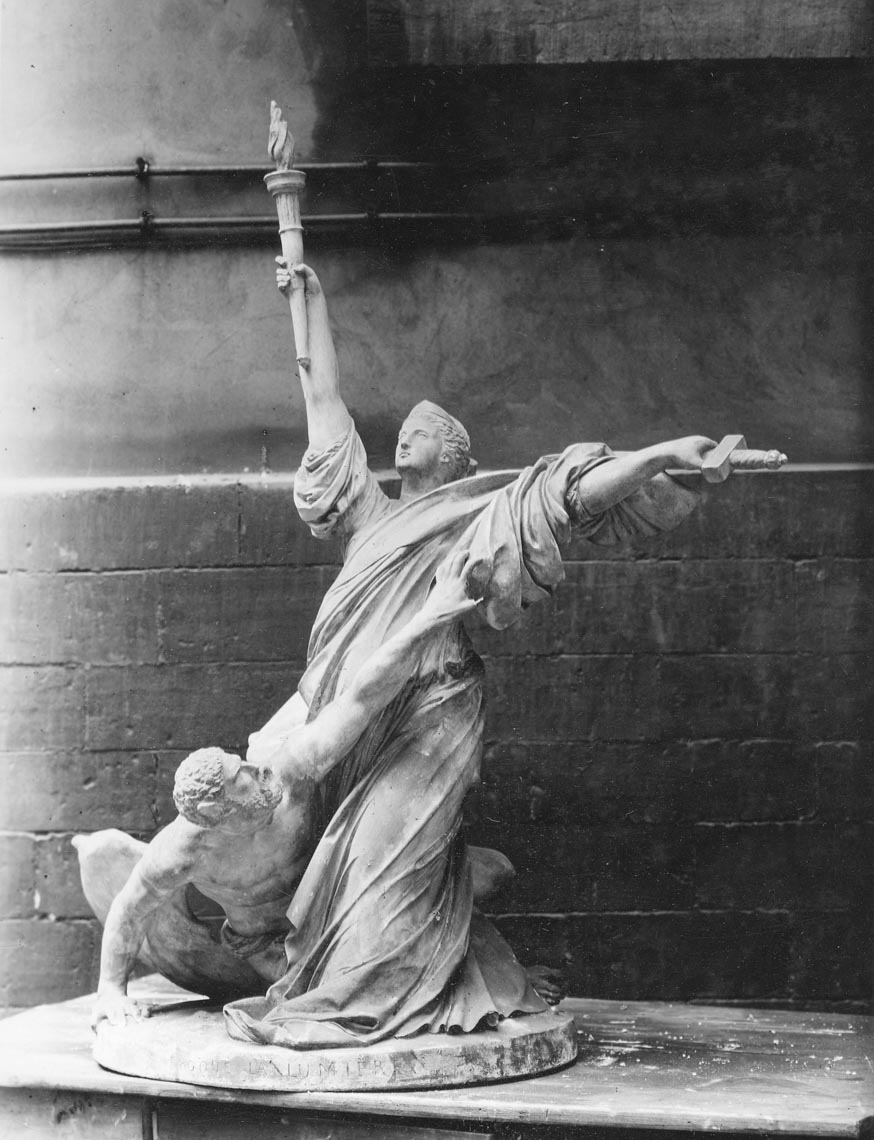
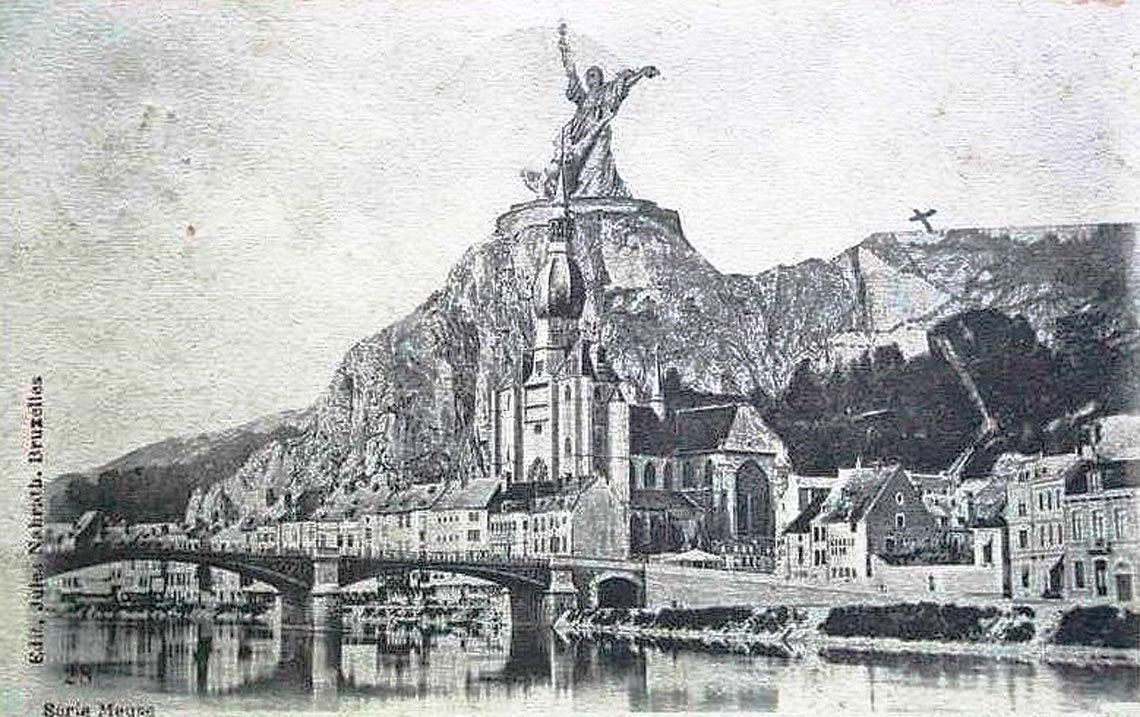
In 1897, the Symbolist painter Jean Delville wrote a vitriolic article on The Human Passions in the magazine L’Art idéaliste. Referring to the comparisons (justified or otherwise) with the great Renaissance master, his piece was entitled Le Michel-Ange du ruisseau (The Michelangelo of the brook). This was a quotation from the eminent art critic Ernest Verlant, whose virulent criticism of Lambeaux’s drawing had included the terms “bacchanal of scum” and “drunken debauchery”. Given the harshness of the judgement, Delville may have painted his monumental work L’Homme-Dieu (The God-Man) between 1901 and 1903 as a response to Lambeaux’s The Human Passions.

Camaraderie artistique, the article published in L’Art moderne on 6 October 1889, was not just an attack on Achille Chainaye. At the time of its publication, rumours were beginning to circulate that Lambeaux’s work was to be commissioned by the Belgian State. As such, the article also could be seen as an attempt to thwart this. The rumours of a public commission were not without foundation. As early as 29 September 1888, before the drawing had been completed, the newspaper Le Soir suggested that the State had “tacitly” commissioned the work.
When the drawing was previewed in Lambeaux’s studio the following year, the critics openly set about inquiring into this idea. Champal, for example, felt that the drawing should be acquired by the State, if only to support the artist, who after all had sacrificed a great deal for the project over a period of several years. Georges Verdavaine went a step further in his article. He thought that the State should have a sculpture made from the drawing and suggested marble as the material, in a nod to Michelangelo in Italy and Pierre Puget and Jean-Baptiste Carpeaux in France. Journal de Bruxelles had absolutely no doubt that the piece was destined to become “a national treasure”, adding that “no foreign country must be allowed to acquire such a magnificent work”.
Jef Lambeaux himself was in favour of this idea, as revealed by a letter dated 12 April 1889 in which he informed the art critic Max Sulzberger, in confidence, that a painter friend, Euphrosine Beernaert, had told him that “the minister” would be visiting his studio, which was then open for viewings of the drawing. While he did not name the politician concerned, Euphrosine Beernaert was the sister of Prime Minister Auguste Beernaert. Clearly, therefore, attempts had been made to interest the government in the project.
In August 1889, when the work was presented at the Ghent Salon, Sulzberger wrote in L’Étoile belge that Alphonse Balat, court architect and vice-president of the Royal Commission for Monuments, recommended that the drawing be executed in marble. When King Leopold II visited the Ghent Salon in early September, Journal de Bruxelles, in its review of the event, subtly noted that the sovereign had been specially introduced to Jef Lambeaux “with whom he spoke for some time”. All the arrangements were put in place for the government to actually commission the work.
By early October, rumours of the commission were already rife. The newspaper Le Bien Public was the first to publish reports that Lambeaux would convert his immense drawing into a marble sculpture for the “trifling” sum of 75,000 Belgian francs. Het Handelsblad also ran the story a few days later under the headline “80,000 francs to turn the house of flesh into marble”. Journal de Bruxelles, however, emphatically refuted the rumours as tittle-tattle: “The Department of Fine Arts simply intends to consult the Royal Commission for Monuments about whether Mr Jef Lambeaux’s drawing could potentially be made into a sculpture and in what proportions.” This was a perfectly reasonable question, and one that Lucien Solvay had also raised. In his article on the drawing at the time of its presentation at the Ghent Salon, Solvay wondered whether the areas of light and shadow in the drawing would disappear once the work was executed in marble or some other material, and whether the disproportions in the design would be ultimately realisable in another medium.
Lambeaux himself was eager for information, as revealed by a letter of 16 October 1889 in which he asked Max Sulzberger if he had any news about Balat’s decision.
When the Brussels World’s Fair was held in the Parc du Cinquantenaire in 1897, the marble relief was not yet ready and there had been talk of displaying the carton in the pavilion instead of the relief. This idea was ultimately rejected, and rumours began to circulate that the canvas could not be exhibited because it had been lost.
The press blamed the loss on Prosper de Haulleville, then chief curator at the Royal Museums of Decorative and Industrial Art in Brussels. He was able to refute this accusation, however, since in fact the government had taken possession of the drawing after commissioning the marble relief. Jules de Burlet, Minister of the Interior and Public Education, had wanted the drawing to be permanently exhibited in the Royal Museums, but unfortunately the building did not have any space big enough to display it. It was therefore, of necessity, rolled up and preserved – “as if it were a vulgar roll of banknotes!”, wrote Het Handelsblad on 6 April 1897 under the provocative headline “Een rolleke van 271,200 fr.” (A little roll of 271,200 francs).
Soon afterwards, Jef Lambeaux’s drawing was transferred to the Royal Museum of Fine Arts Antwerp.
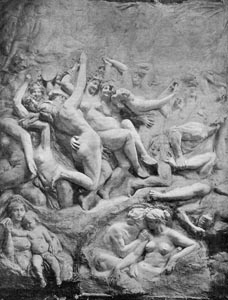
The Dutch translation of the word Passions as Driften, with its connotations of lust, gave rise over time to a misinterpretation of the work. As the relief was off limits to the public for a long time, a legend grew up that this was due to its immoral character.
It is striking, therefore, that the question of morality or immorality was never raised when the drawing was exhibited at the Ghent Salon. It was not until October 1889 that the Catholic daily Le Bien Public suddenly judged the work to be indecent. Previously published reviews of the drawing – including in Le Bien Public – when it was still on display at the Salon suggest that the only questions being asked were what exactly it represented and what the underlying idea was.
There came an abrupt change of tone in October, when several articles in Le Bien Public homed in on the immoral nature of the work. The paper’s critic launched an excoriating attack on Joseph Devolder, then Minister of Public Education and a member of the Catholic Party. In bombastic style, he demanded of the “Christian and paterfamilias” whether he wished to “corrupt” the nation’s youth with such a “scandalous exhibition”. He even made a comparison with Félicien Rops, an artist known for his salacious pictures, sold (according to the author) under the counter. In a second article, the paper took umbrage at a piece in Journal de Bruxelles defending the Lambeaux drawing:
“After seeing Humanity, the deliberate indecency of the poses, the lascivious and bestial expressions of a procession of women filling an entire side of the panel, we say: no, this is not something that can be brought before the gaze of an entire people!”
The protestations of Le Bien Public were not echoed elsewhere in the press, and the debate did not flare up again until 1892. This time it was not in the press but in the Belgian Senate, where the then Minister of the Interior Jules de Burlet had to answer parliamentary questions about the public commissioning of the work and its allegedly immoral nature. The discussion focused on the price paid, and de Burlet replied in these terms: “Is the work immoral? Certainly, there is nudity, a great deal of nudity, including entire groups; but one must pay attention not to the details but to the work as a whole [...] I do not deny that, from the point of view of taste, certain details are open to criticism, and I hope that, in the final execution, the artist will be able to make some judicious adjustments. But to call his work immoral is, I believe, to misjudge it!” This brought the matter to a close once and for all.
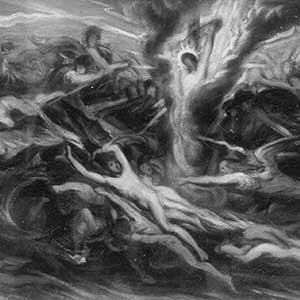
A photograph showing a clay model of the relief has been preserved. This rudimentary version differed significantly from the carton. That could mean that it dated from before the drawing was put on canvas, although this is far from certain. In the clay version, the character of Death takes centre stage, but rather than forming the structural core of the whole composition, Death pushes back the various groups in a centrifugal movement. This is a totally different starting point.
There is also a bronze relief in the collections of the Royal Museums of Fine Arts of Belgium. Compositionally, it is much closer to the drawing and more than likely represents an intermediate stage. The main difference between this bronze and the final marble relief is that Death is not at the centre. The focal point is Christ on the cross. Perhaps Lambeaux had been overly influenced by Antoine Wiertz’s painting The Triumph of Christ, or possibly some critics who had questioned the central role given to Death had touched a nerve with the sculptor.
By the time Lambeaux opened his studio in October 1894, the plaster model of The Human Passions, cast from the full-size clay model, was complete. This was the definitive version of the composition, whose final incarnation in marble would not be finished until 1899.
The colossal relief, measuring 6.32 x 11.17 m, was carved from white Carrara marble (bianco Carrara statuario). It consists of 16 blocks to which marble elements have been affixed in some places.
The composition is divided into two main groups, separated by the character of Death in the form of a skeleton. Death’s skull is at the very top and dominates the composition. The skeleton has its right arm raised and is partially enveloped in a transparent veil.
The group below Death on the bottom right mostly consists of naked, muscular, athletic men, wrestling and fighting with weapons, and looking tormented and overwhelmed by emotion. In the midst of this tumult, we find the figure of Christ on the cross.
The group on the left is dominated by sturdy, naked women gleefully moving their arms while a satyr plays the tambourine. Beneath them are two scenes representing islands of calm within the composition: a woman holding a child on her knees and a pair of lovers.
Jef Lambeaux himself never identified the groups featured in the relief. As with the work’s title, he left this up to sympathetic journalists whose reviews included detailed descriptions of the groups. Lambeaux’s letters show that he was in personal contact with these journalists, so there is every reason to believe that their proposed identifications were based on what the sculptor had told them or, at least, that he approved the names given.
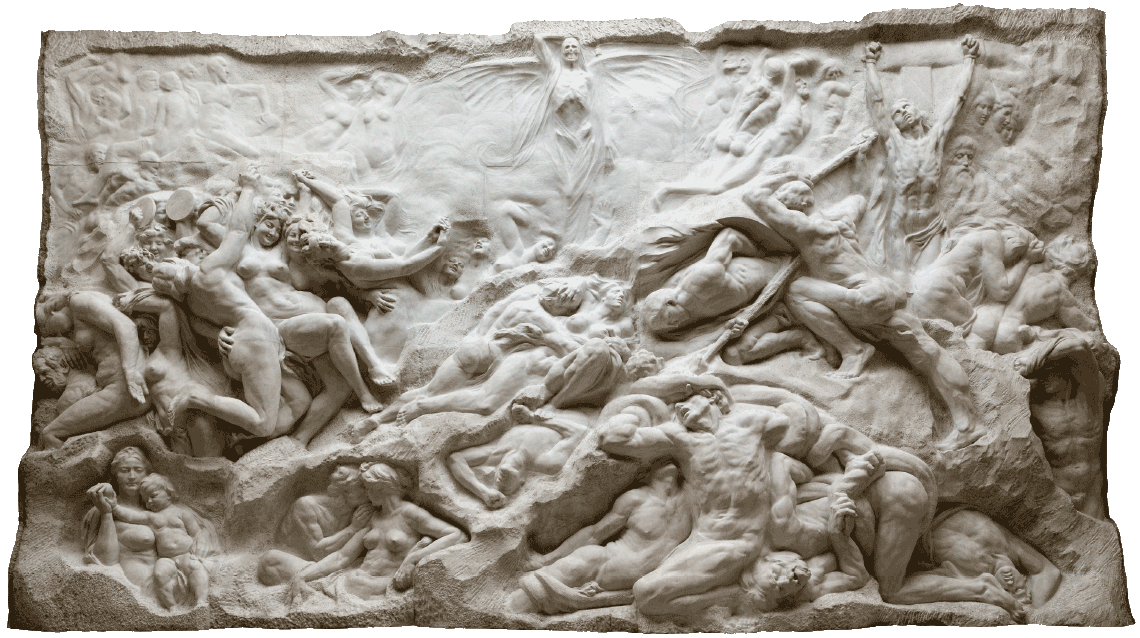

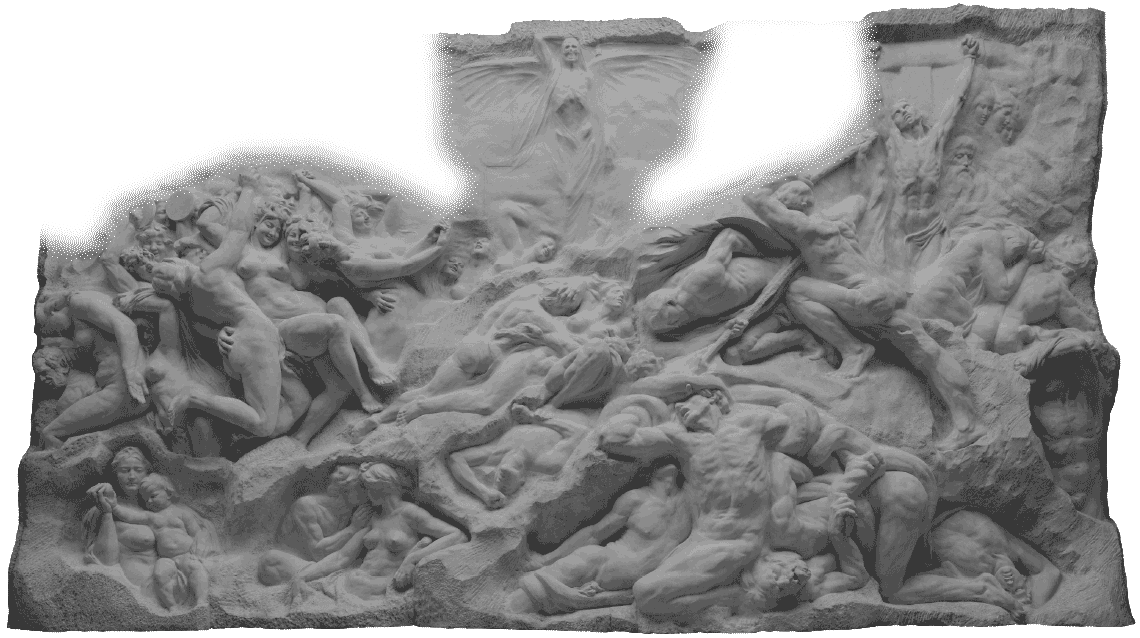
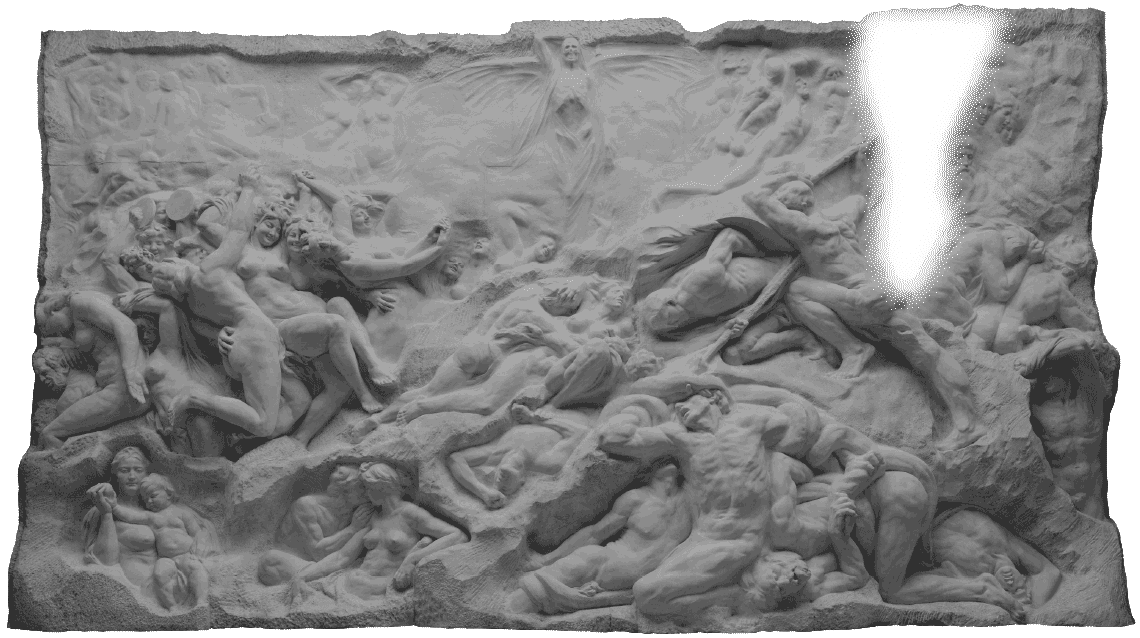


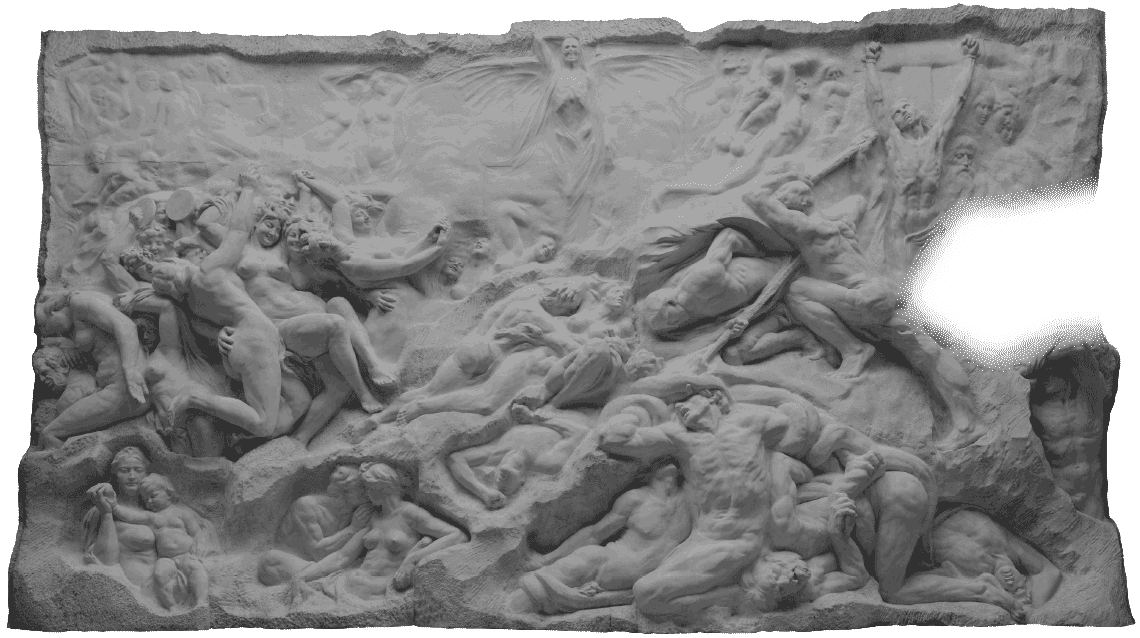

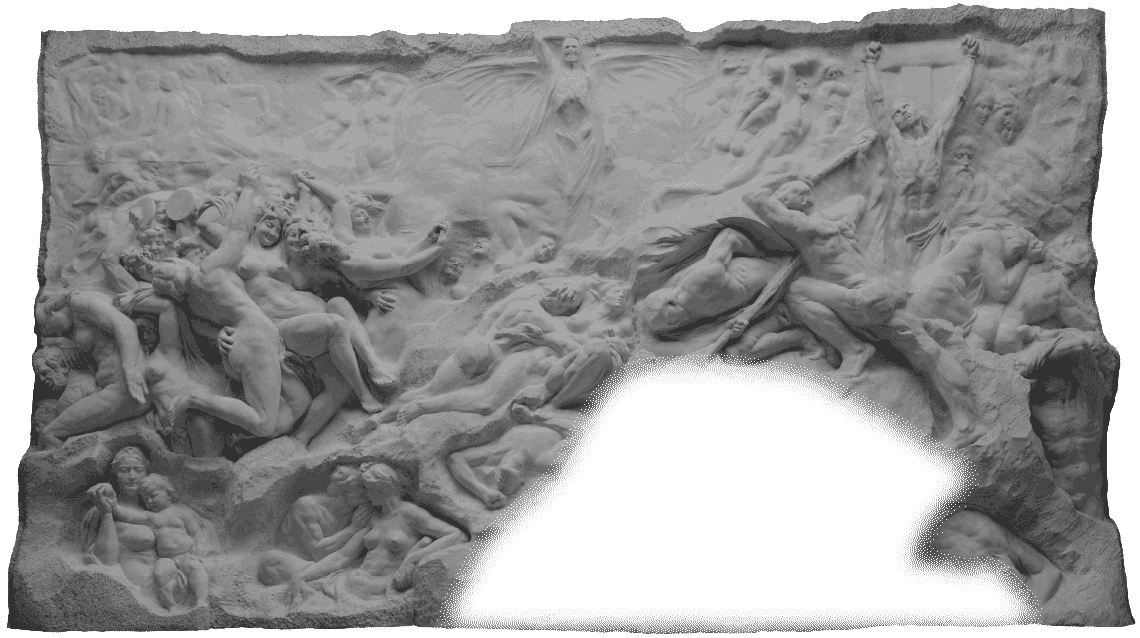
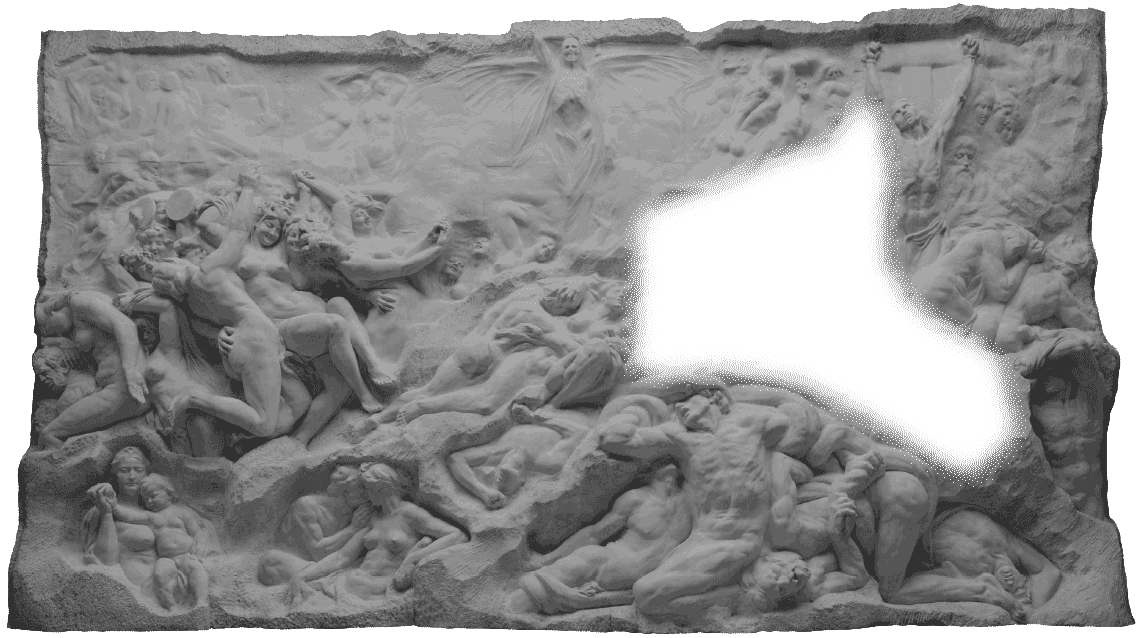

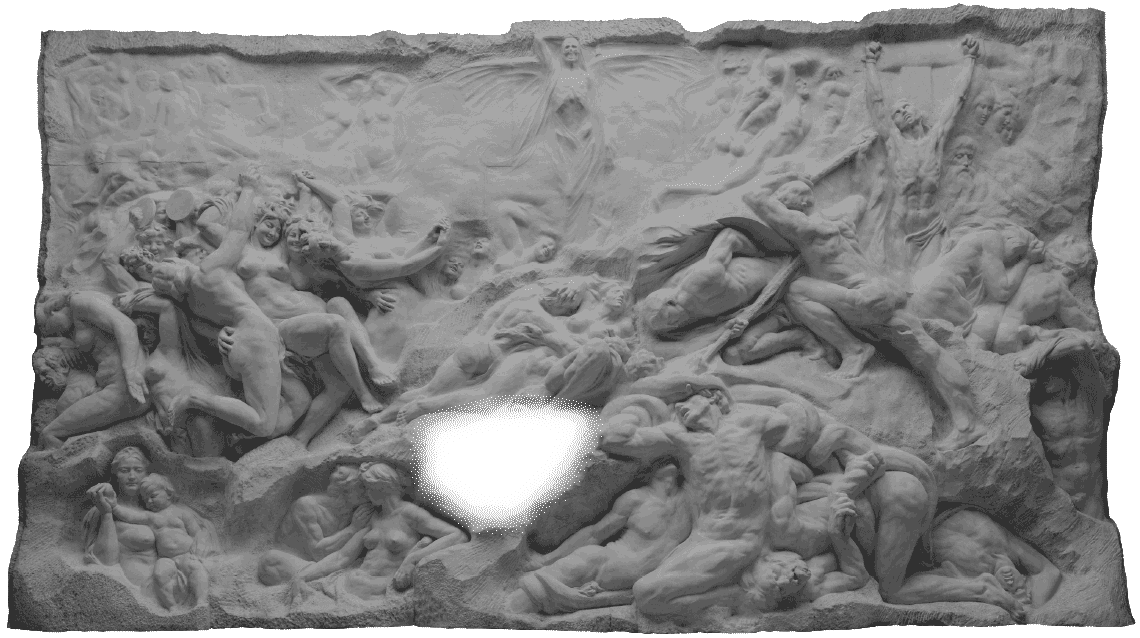
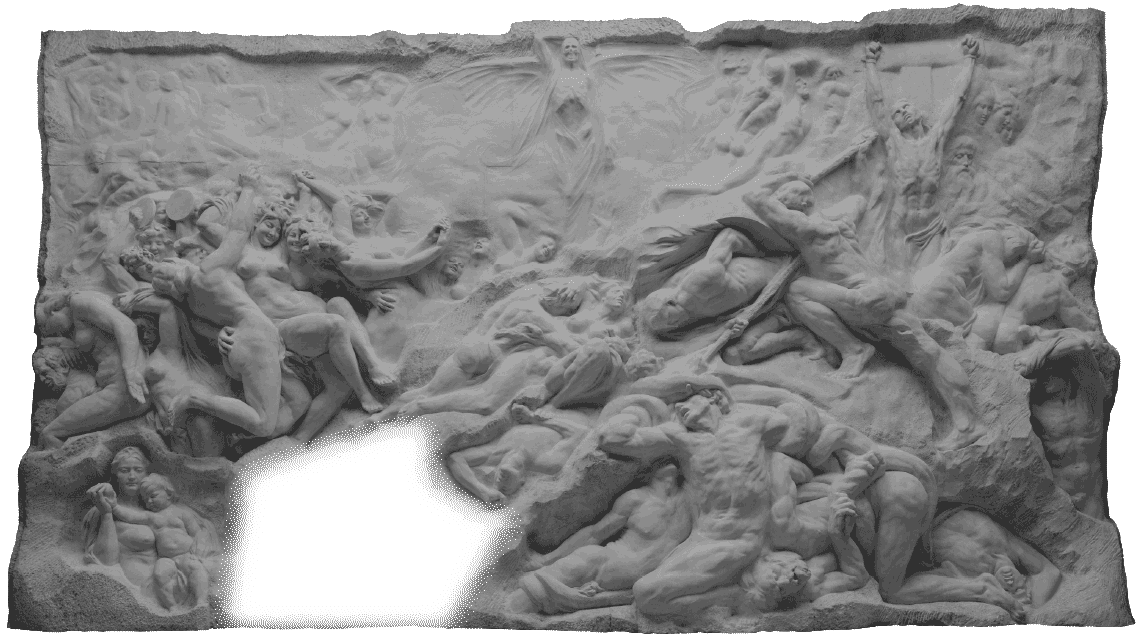
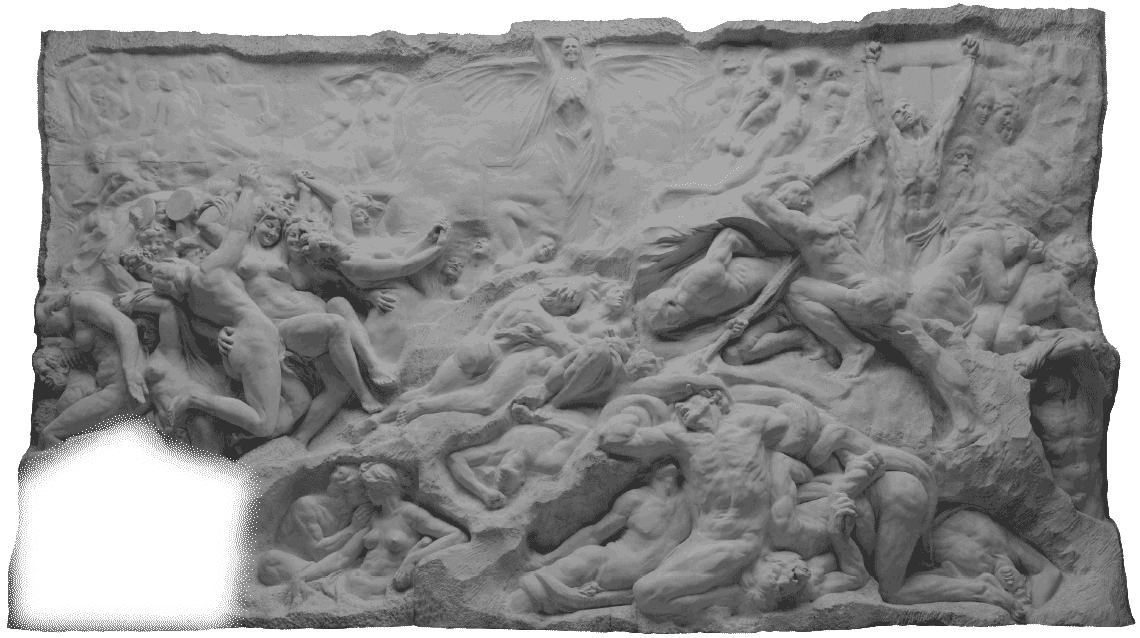
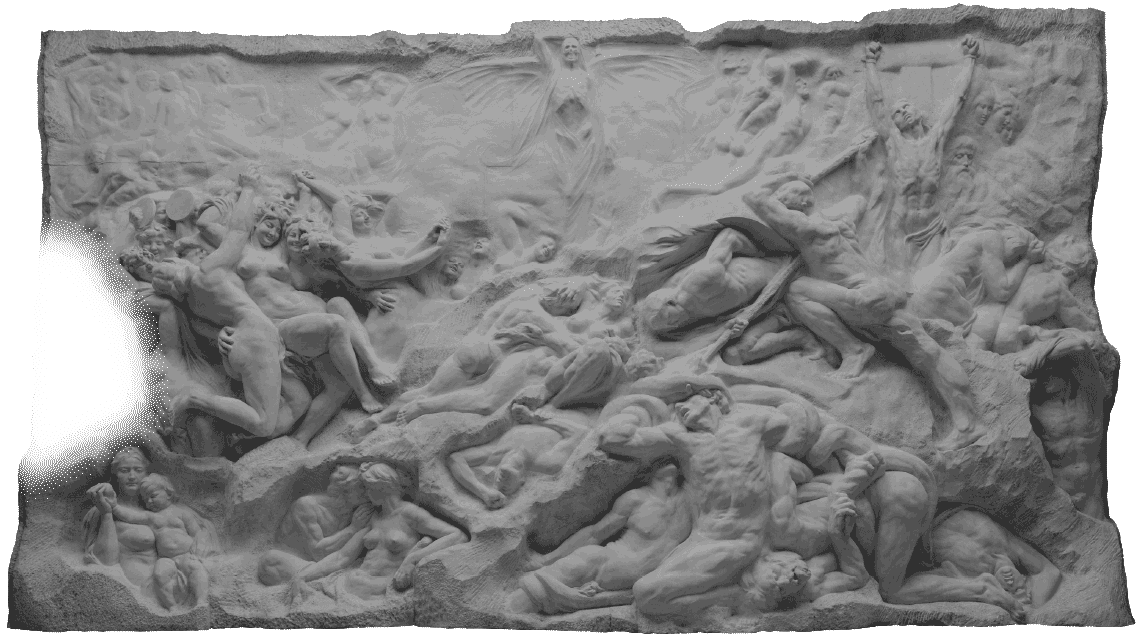
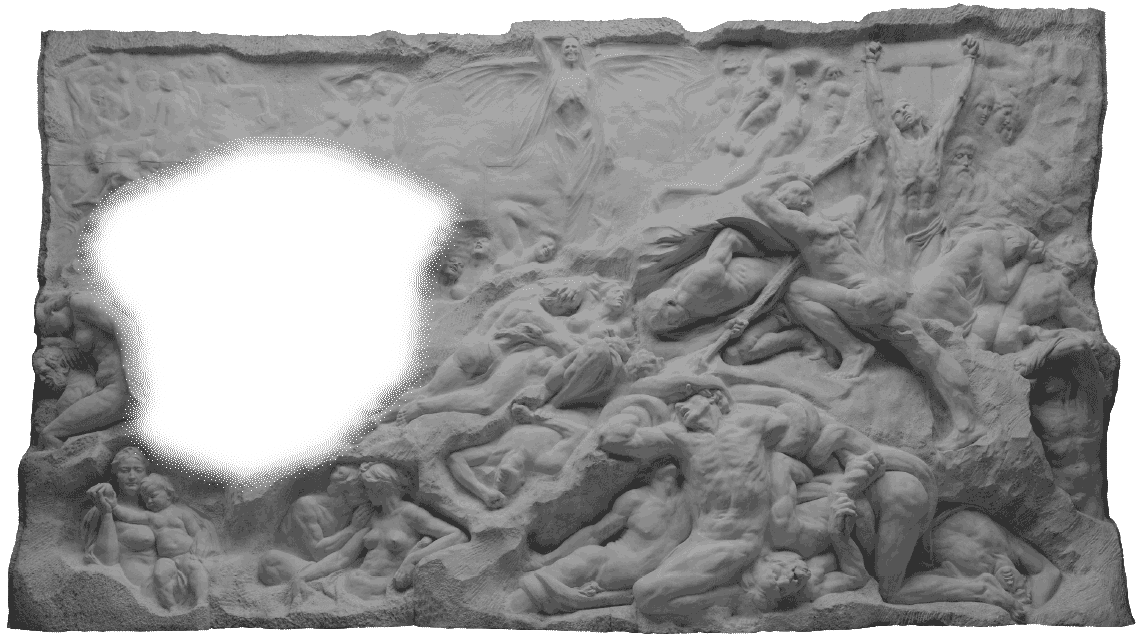

Just as he never identified the groups, Lambeaux said virtually nothing about the meaning of his creation. This was neatly encapsulated by the newspaper Journal de Bruxelles, which was a keen advocate of the work: “We believe that Mr Lambeaux’s philosophical intentions are modest. He has sought to convey an artistic impression rather than to formulate a system of philosophy in plastic form. It is likely that he is unfamiliar with Descartes and Spinoza and that he did not have Schopenhauer on his mind during the creative process. The subject of his work is simple; we should not try to find in it things he did not intend to put there.”
The journalist then proceeds to give a rather obscure interpretation of the piece, namely that it expresses the idea that vanity (on the right) and joy (on the left) lead to death (in the centre). In other words, it is all about human vanity and the Last Judgement. There are, however, many related scenes, some of Biblical origin and others drawn from mythology, to which he does not refer and which are not mentioned in other contemporary writings either. It may be that this does not matter and that the artist was simply trying to achieve an aesthetically harmonious whole in which all these representations merge.
A committee was established in 1899 to arrange for Jef Lambeaux’s work to be exhibited abroad. With the Belgian State’s agreement, a plaster cast of the marble relief was made and featured prominently in an exhibition that toured various European cities: Scheveningen (The Hague), Berlin, Munich, Dresden, Vienna and Paris. In the French capital, the relief was on show at the 1900 World’s Fair in a specially designed pavilion. With Lambeaux’s agreement, the cast was then handed over to the Museum of Fine Arts in Ghent in 1905, and it has been in one of the rooms there ever since.

Once the decision had been taken to commission the marble relief, the question was: where could such a huge work be displayed? Initially, the plan was to incorporate it into an existing public building, such as the Palace of Justice, or the Palais des Beaux-Arts/Paleis voor Schone Kunsten that had recently been built on rue de la Régence/Regentschapsstraat to a design by Alphonse Balat. However, the location ultimately chosen was the Parc du Cinquantenaire/Jubelpark, laid out 10 years earlier to plans by Gédéon Bordiau to commemorate 50 years of Belgian independence.
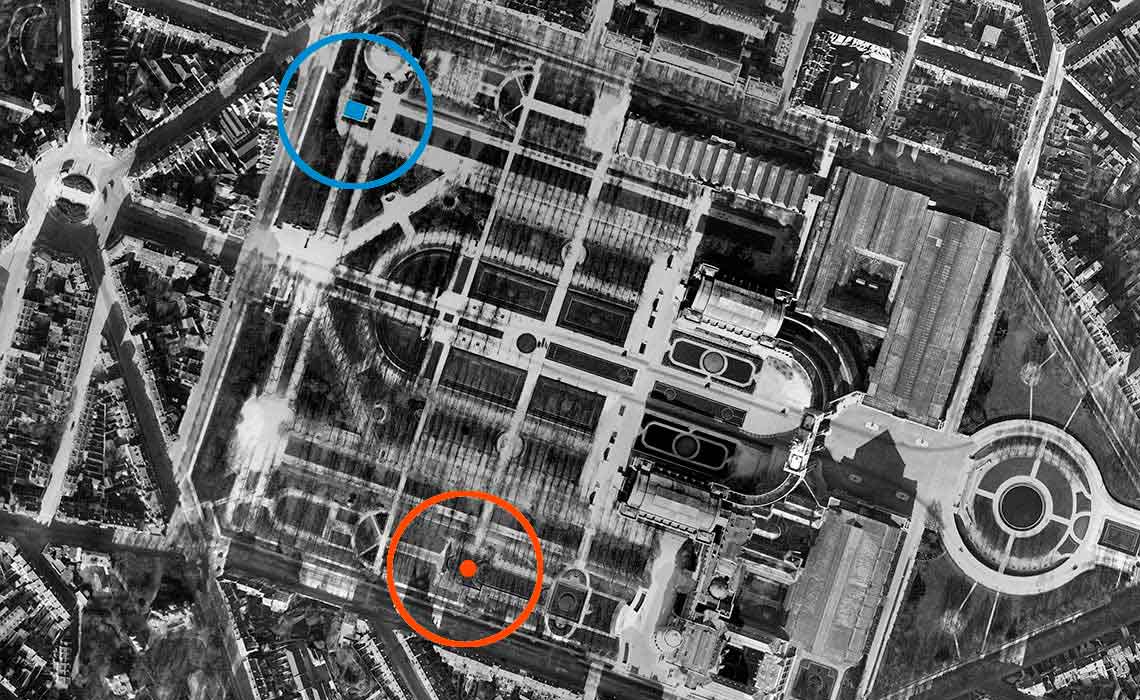
As vice-president of the Royal Commission for Monuments, which had already been consulted about the commissioning of the relief, Alphonse Balat played a key part in this decision and in the appointment of his young student Victor Horta to design an architectural showcase suitable for the work. The contract, signed on 8 August 1890, committed Horta and Lambeaux to completing the whole project within eight years. The budget for the sculpture was 171,200 Belgian francs, while 49,687.50 francs was paid for the pavilion to house it.
With the commission assigned, negotiations soon got under way about the work’s location in the park. Initially, the planned site was a walkway running across the south side of the park, but Horta, citing the costs of levelling the land and the “damp and defective nature of the soil”, convinced the sponsors to opt for a location in the north-west corner instead, and this is where the pavilion ended up being built. As Horta noted: “situated on the most beautiful avenue, adjacent to a part of the park that is not yet wooded, it fulfils all the conditions of the initial site but has none of the major drawbacks.”
Victor Horta attended the Department of Architecture at the Ghent Royal Academy of Fine Arts from the age of 12, and following a period in Paris, enrolled at the Royal Academy of Fine Arts in Brussels. In 1883, while still a student, he was taken on as a trainee architect by Alphonse Balat.

In 1884, he was one of three winners of the Godecharle Prize for his design for the Belgian Parliament, in Balat’s style. Established six years earlier, this triennial competition enabled young artists to travel for three years to complete their training. To the annoyance of the award committee, Horta only made short stays in Germany and France. Having been married since 1881 and eager to embark on working life, the young architect was reluctant to leave Brussels. Despite not travelling to Italy or Greece, he showed an interest in classical architecture. Required by the competition rules to design a masterpiece abroad for submission to the Cinquantenaire Museum (the present Art & History Museum), he drew up a graphic restitution of the Temple of Augustus and Livia in Vienne, France. Comparing the façade of the imperial edifice with the façade of the Pavilion of Human Passions clearly highlights the originality of Horta’s details.
While the Pavilion of Human Passions was the young Horta’s first public commission, it was not the first of his designs to be built. In 1885, he was tasked with designing a group of three houses in Ghent, the city where he was born. Aside from the exposed brick façades and windows topped with semicircular arches, it was the architect’s collaboration with two artists, a painter and a sculptor, that was considered the most original feature of the project at that time. Adrien De Witte created a frieze of sgraffito under the cornice, while Hippolyte Le Roy decorated the sills of the first-floor windows with bas-reliefs. Inspired by the British Arts and Crafts tradition, this union of the arts foreshadowed the later achievements of Horta and of the Art Nouveau movement more generally.

With Lambeaux’s agreement, Horta designed the pavilion as a small neoclassical temple that would allow the public to see the relief while protecting it from the elements. The building consisted of a single space, its width (14 metres) tailored to that of the sculpted relief that occupied its rear, in front of a technical recess accessed by a back door. The pavilion was open to the park through a portico of four columns flanked by pilasters, carrying the entablature and pediment. A pitched glass roof ran the full length of the building, providing overhead lighting for the sculpture in addition to the front light entering via the façade. The building’s austere look recalled the architecture of Alphonse Balat who, unlike his contemporaries Léon Suys and Jean-Pierre Cluysenaar, favoured minimal decoration and elegant simplicity. “Simplify, simplify again, simplify once more, and when you’ve simplified everything, you still won’t have simplified enough”: Balat’s mantra appears to have been taken up by his student Horta, and also applies to the pavilion’s materials, which were left natural and exposed.
Upon closer examination, however, it can be seen that Horta used the architecture of antiquity as a spur to invention rather than a binding model. Looking carefully, one can see the original way in which he treats the basic elements of the classical temple, namely the plinth, columns and entablature. The young architect creates dynamic and subtle transitions between the walls of the temple and its base, between the columns with their new-look capitals and the entablature flexibly positioned on top, carrying a pediment with tightly curved slopes. It is therefore easy to see the germ of Art Nouveau principles in the design of this small temple. In his Memoirs, Horta confirmed that a lot of work had gone into these curves, which were “lost on those who don’t take the trouble to look”.
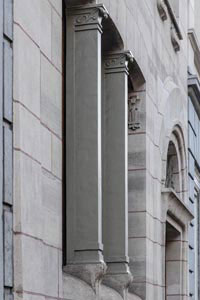
“What? You dare to invent profiles when you have so many beautiful examples from the past at your disposal?” Balat’s question to his student about a plinth design for a sculpture Horta was working on around the same time as the pavilion, highlights how the Pavilion of Human Passions both follows on from, and breaks with, the teachings of the past and, beneath its deferential exterior, marks an audacious distancing from classical architectural language. This distancing would develop very quickly in the years ahead, most notably with the Hôtel Tassel and the Autrique House just three years later.
“Did people think that the curved lines I introduced into my architecture were some sort of whim? I had been aspiring towards them ever since I left school, even when I was with Balat and fully under his influence. The Cinquantenaire building is proof of that: it contains not a single straight line, all the verticals are curved. However, this aspiration was based on the same spirit, that of the curved contours of the columns, which had been around for centuries but which had never been translated or transposed to the other elements of the architecture.”
Horta, Mémoires (Memoirs), p. 16
Work began in the autumn of 1891, before a planning application had even been submitted. To rectify this, Horta sent a set of outline plans to the council in May 1892. In September 1893, the building was covered with a temporary roof so that the plaster version of the relief, which the sculptor was working on in his studio, could be installed. Cast from the full-size clay model and showing the work in its final composition, this plaster version was completed in October 1894. Lambeaux opened his studio for the occasion.

While Lambeaux and Horta appear to have agreed quickly on the kind of building that would house the relief, their collaboration was marked by disputes and misunderstandings. Despite the 1:20 model paid for by the Royal Commission for Monuments which was kept in the sculptor’s studio to enable him to judge the lighting conditions for his work, Lambeaux kept changing his mind about various aspects of the building. Horta saw these demands as a way of gaining more time to complete the relief while blaming the delays on the architect.
Neither the relief nor the pavilion were ready for the 1897 World’s Fair, which was split between the Cinquantenaire and Tervuren Parks. The Carrara marble blocks ordered for the final version of the relief were not delivered on site until March 1897, just before the exhibition opened, and the pavilion under construction can be seen in the event’s official publication. It should be noted that, at the time, the pavilion was considered much less important than the sculpture, which was displayed in its plaster version. While the above-mentioned publication featured a long and complimentary review of the relief by Lucien Solvay, followed by a biography of Lambeaux, the architecture of the pavilion, described as a “superb small Graeco-Roman portico”, attracted no comment at all, and Victor Horta’s name was not even mentioned.
In the years that followed, the pavilion became a workshop for the sculptor, who produced his work in situ, with a temporary wooden partition erected to the rear of the columns. The final version of the sculpture was eventually unveiled on 1 October 1899, although the pavilion still lacked its finishing touches.
“We had already seen Lambeaux’s bas-relief in his studio on Hollestraat in Saint-Gilles, but that was a plaster version whereas here we have it in marble, with its final lighting – although not quite final perhaps, as it seems that some further work is needed (...) to bring light to the base of the bas-relief. Here the artist has grouped the preparatory episodes which, while not being drawn into the furious melee of the magnificent and tumultuous composition, are not there simply to serve as a repoussoir in the half-light. The overall effect is no less superb, powerful and moving. A few more strokes of the mallet are needed, but all the same, we have before us the vision of the work in its final form.”
L’Indépendance belge, 31 October 1899
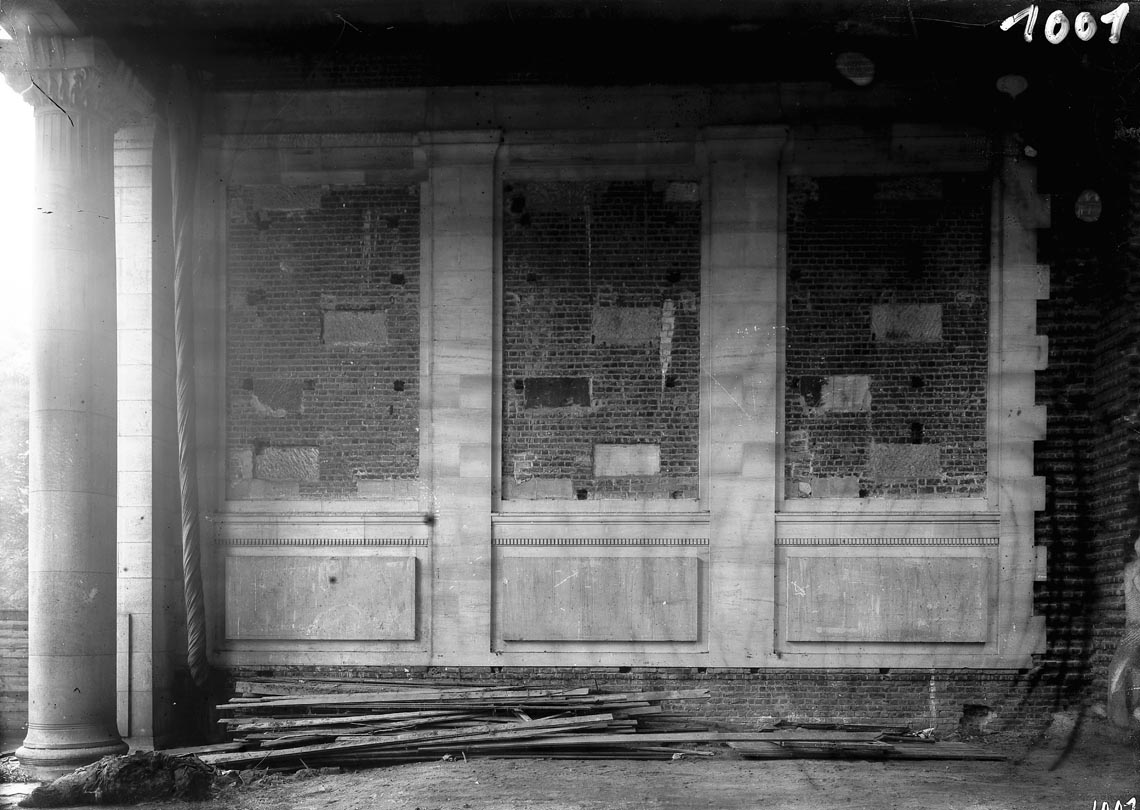
The opening of the pavilion proved to be very short-lived: after just four days, a barricade was erected to prevent access. The building had been designed to be open to the park, allowing the relief to be seen behind its columns. Now, however, it was to be enclosed, at the risk, according to the newspaper Le Soir, of “impairing the distance needed to view the work properly as a whole”. Was this change demanded by the sculptor or prompted by puritanism? According to Horta, Jef Lambeaux was disappointed with the effects of natural light on his work and used the scruples of one section of the Catholic government as a pretext to have the building enclosed. Lambeaux himself denied playing any part in the decision, subsequently laying the blame entirely at the door of the government, which “does not want The Human Passions exposed to public view because it considers the work immoral”. Whatever the true reason, Victor Horta was asked to look at enclosing the building, which he refused to do on the grounds of architectural harmony.
The years passed and nothing happened, not least because the government was reluctant to incur additional costs in modifying the building. The pavilion thus joined the neighbouring Cairo Panorama building, constructed for the 1897 World’s Fair, and the still unfinished Cinquantenaire Arcade as examples of government inefficiency and squandering of public funds. Even before it was completed, the temple was in need of repair following damage (blamed on “young tearaways”) to the glass roof.
It was not until October 1904 that, at the instigation of the Royal Commission for Monuments and following criticism by the sculptor, experiments were undertaken to adjust the natural lighting of the relief. These trials, which continued until at least January 1905, involved concealing more and more of the lantern that originally took up most of the roof, so that in the end, light only fell onto the very centre of the relief. At the same time, curtains were fitted at the back of the columns to close off all or part of the front façade. The experiments appear to have been successful, as in their wake Horta was asked to modify his design so as to enclose the pavilion. The architect agreed only grudgingly, and on condition that it would not involve simply building a wall between the existing columns. Photographs taken at the time show that the interior finishing had still not been added.


“The temple that may one day house Lambeaux’s bas-relief is lamentably incomplete. It is an intractable Greek-style enigma, its stonework not yet smoothed, its prolonged silence set to become a Brussels institution. The façade is horribly defiled, young tearaways having adorned the columns with words and drawings that are anything but classical. A padlocked wooden door, ill-fitting partitions, bays closed off with torn canvas, and the combined ravages of winter and damp give this temple, amid its forlorn preparations, the appearance of a youthful ruin.”
L’Indépendance belge, 14 March 1901
In September 1906, Horta delivered a new set of outline plans to the Ministry of Public Works that would be carrying out the work. In his Memoirs, he claims that he did the work for free, such was his hostility to the planned changes. The columns were to be brought forward from their original position and replaced with a solid wall, in which there was a door leading to an anteroom. To prevent light from entering through the whole of the glass roof, the architect planned to install a ceiling at tie-beam height spanning the first two bays, with a metal-framed translucent roof lantern over the third bay.
Aside from these required changes, Horta seems to have wanted to take the opportunity to add carved decorations to the temple’s principal façade. The pronaos (vestibule) created by bringing the columns forward was to support a group of carved figures in the form of a pediment, placed in front of the original pediment. The new façade, containing the door to the interior, would be adorned with decorative wreaths and garlands in a long horizontal cartouche, the latter mirroring the smooth-surfaced cartouches included on the side walls of the temple as part of the original design. Apparently, there were also plans to add groups of carved figures on the side walls, along the projections marking the thickness of the bas-relief. However, these carved decorations were never realised.
While the press welcomed the fact that the problem of the pavilion had been resolved at last, and admirers of Jef Lambeaux proclaimed to all and sundry that the lighting experiments had proved the sculptor right, Horta remained bitter, setting out his point of view in an open letter published in L’Indépendance belge on 14 April 1907 and in the following day’s edition of Le Soir. He said that he would never come to terms with the changes he was forced to make, especially since they had the effect of hiding from view a work he very much admired. When he came to write his Memoirs, he remained gleeful at the difficulties the Ministry of Public Works had had when surveying the pavilion prior to the detailed plans being drawn up: it had taken them over a year, he said, “so time-consuming was it to draw all the curves, joins and profiles by hand”.
“Does that mean that I agree with the principle of the remodelling and am in favour of enclosing a building that was intended to be a place of repose in a public park, with a simple barrier to protect it from vandalism? By no means! I like works to be seen in broad daylight, and attach only relative importance to the ‘right location’ or charmingly contrived lighting; moreover, the idea of this miniature museum with all the burdens it will entail in the future is something that will never be to my liking. But that is Mr Lambeaux’s business, whose work here is a masterpiece.”
Open letter from V. Horta in Le Soir, 14 April 1907
The working drawings and specifications were drawn up by the Civic Buildings Department in 1909. As well as the problems carrying out the survey, the work was also held up by staffing issues. The design put out to tender on 18 June 1909 was developed based on the documents submitted by Horta in 1906 but did not follow them in all respects: rather than concealing part of the existing glass roof, it involved replacing this with a smaller skylight and constructing a zinc roof, hidden from the inside by an antique-style coffered ceiling. The carved decoration planned for the new façade was not included in the specifications and was never to be executed, to Horta’s great regret. However, the plans did include interior decorations, and these were realised: a white, yellow and red polished mosaic was incorporated into the floor, and the walls, whose brick structure had hitherto been left partially exposed between the Savonnières limestone pilasters, were clad in yellow Siena marble panels. The relief was edged with Euville limestone.
The contract, worth an estimated 71,000 francs, was awarded to De Booserie, contractors based in Schaerbeek/Schaarbeek. As Horta had refused to supervise the work, it was overseen by an architect named Serrure from the Civic Buildings Department. The relief was covered with protective planks for the duration of the work.
Jef Lambeaux, who despaired of the work ever being finished and blamed the delays on his alleged “paganism”, did not live to see the final result: he died in June 1908 and is said to have asked to be buried under the pavilion. The fact that there was no government representative at his funeral would appear to confirm the reservations that much of the ruling Catholic political class had about him.
By contrast, a group of artists went to the pavilion after the funeral service and nailed a wreath on the barricade in protest: “On behalf of the master himself, his friends and admirers, we hereby make the solemn vow that we shall soon, at the earliest possible opportunity, see the masterly work of Jef Lambeaux arise from this sepulchre in which it is concealed.” The fact that this procession was led by the painter Jean Delville is surprising, given that 11 years earlier he had described The Human Passions as “filthy pig-flesh debauchery” and a “tavern bacchanal”.
“Do you want my honest opinion? … The Human Passions will never be seen. (…) Because the minister doesn’t want it to be (…). Someone once said to me, ‘You are a pagan!’ and that’s the line that gets trotted out against me at every opportunity. They reproach me for having no religion other than my art.”
Jef Lambeaux in Le Soir, 22 October 1906.
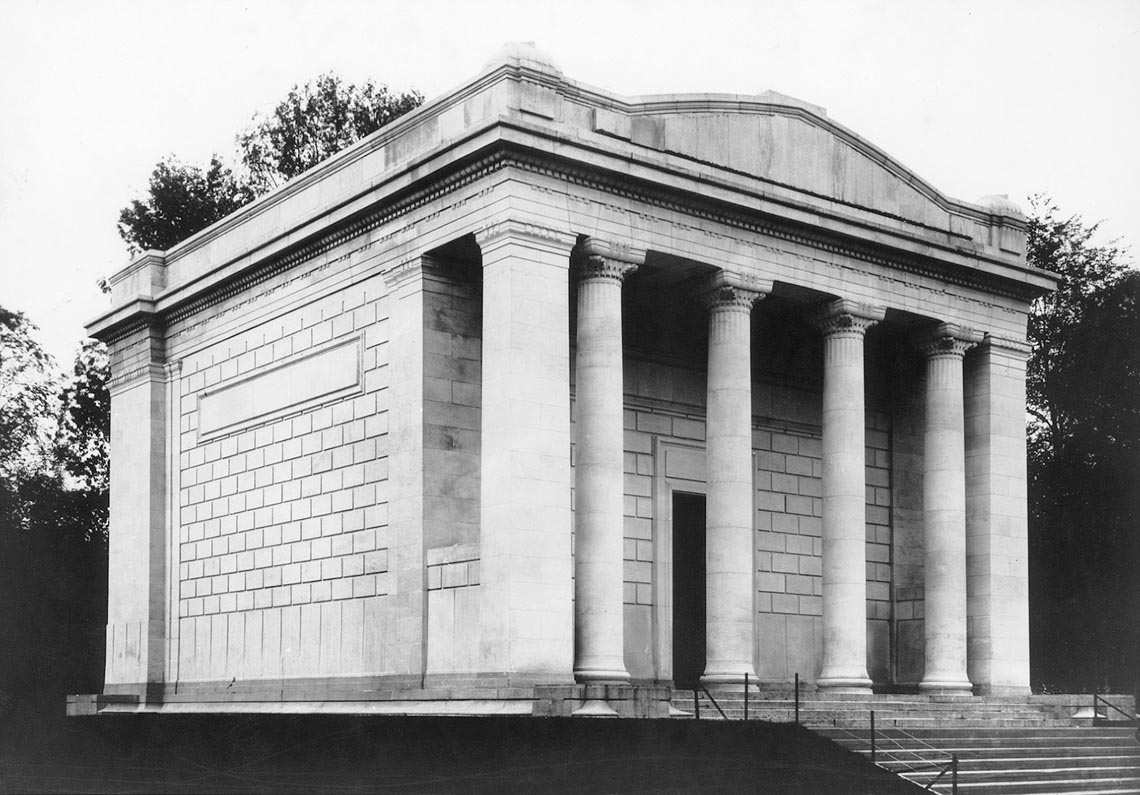
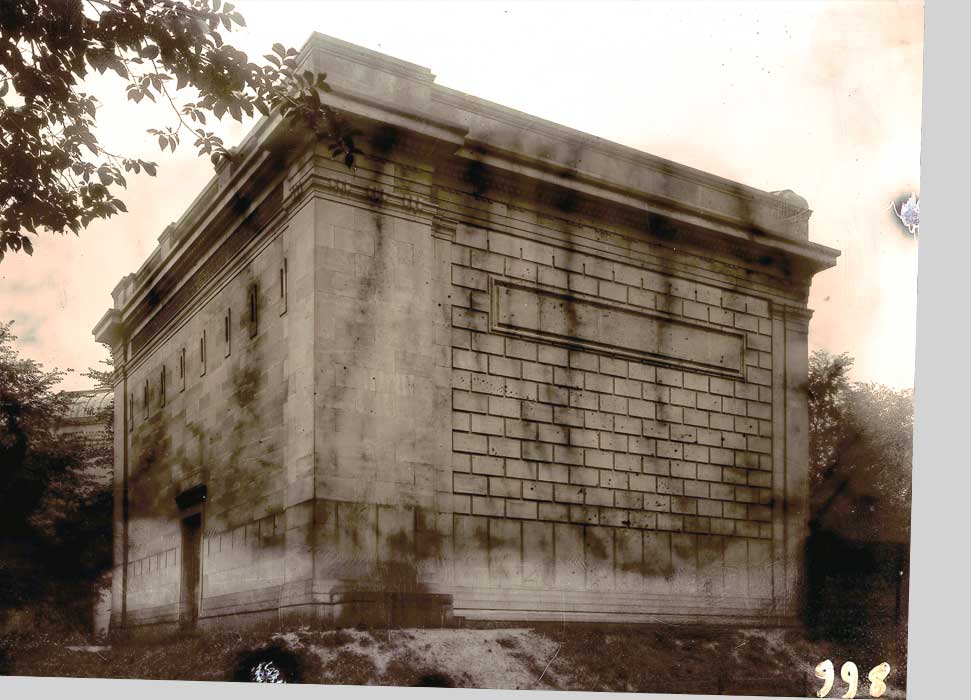
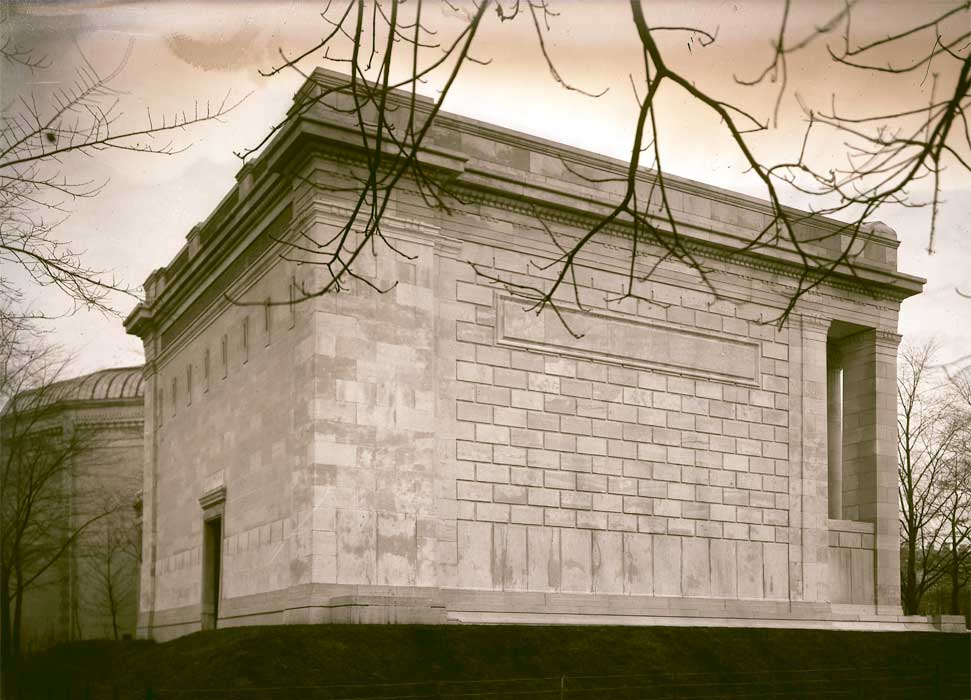
As the work neared completion in July 1910, minor repairs were undertaken on both the pavilion and the relief. Inside, a velum (veil) was installed under the roof lantern to further reduce the amount of light falling on the sculpture. The surrounding area was also given a makeover, with turf from the nearby lawns placed on the mound bearing the monument. In September 1910, 20 years after it was commissioned, the Ministry of Public Works announced that the pavilion could be opened to the public. There was no ceremony to mark the event.
The pavilion was considered a “miniature museum”, to use Horta’s words, and placed under the responsibility of the Fine Arts Department in January 1911. As it was not possible to arrange permanent surveillance for a building housing a single artwork, and which lacked any form of heating, the pavilion was only opened very occasionally – something regularly bemoaned by the press, with varying degrees of sarcasm. With no caretakers or security guards on site, acts of vandalism were commonplace.
“(…) I climbed the wooden steps leading to the peristyle of the temple in which Lambeaux’s masterpiece is enthroned. It has only been open for a few days but already many hands have desecrated it. The walls and the shafts of the columns are covered with silly and obscene inscriptions. Does no caretaker or guard ever come to check on it? Just because this elegant mausoleum houses a work of art, that is no reason why budding artists should be allowed to try out their nascent talents on its stonework, mindlessly scrawling the little houses, birds, people and worse that adorn (?) the façade – not to mention the dozens of pencilled names, the silly slogans and those stupid phrases that people are accustomed to scribble in all public places.”
Le Soir, 2 March 1911
In the years that followed, the pavilion was opened sporadically, with frequent periods of closure in between. From 1923 to 1925, it was at least open to the public during the opening hours of the Royal Museums of Art and History; it then reopened in July 1935 after being closed for several years, during which time, according to L’Indépendance belge, The Human Passions could only be viewed by “a privileged few”. There are no records or press reports indicating whether the building remained open in the years after that, but it appears to have been closed permanently in 1939. Neglected and unattended, it fell prey to vandalism: the front door was forced open on multiple occasions while the rear entrance was set on fire and replaced with a metal door, probably in the late 1960s. On the 50th anniversary of the completion of the building work, there were some occasional mentions in the press.
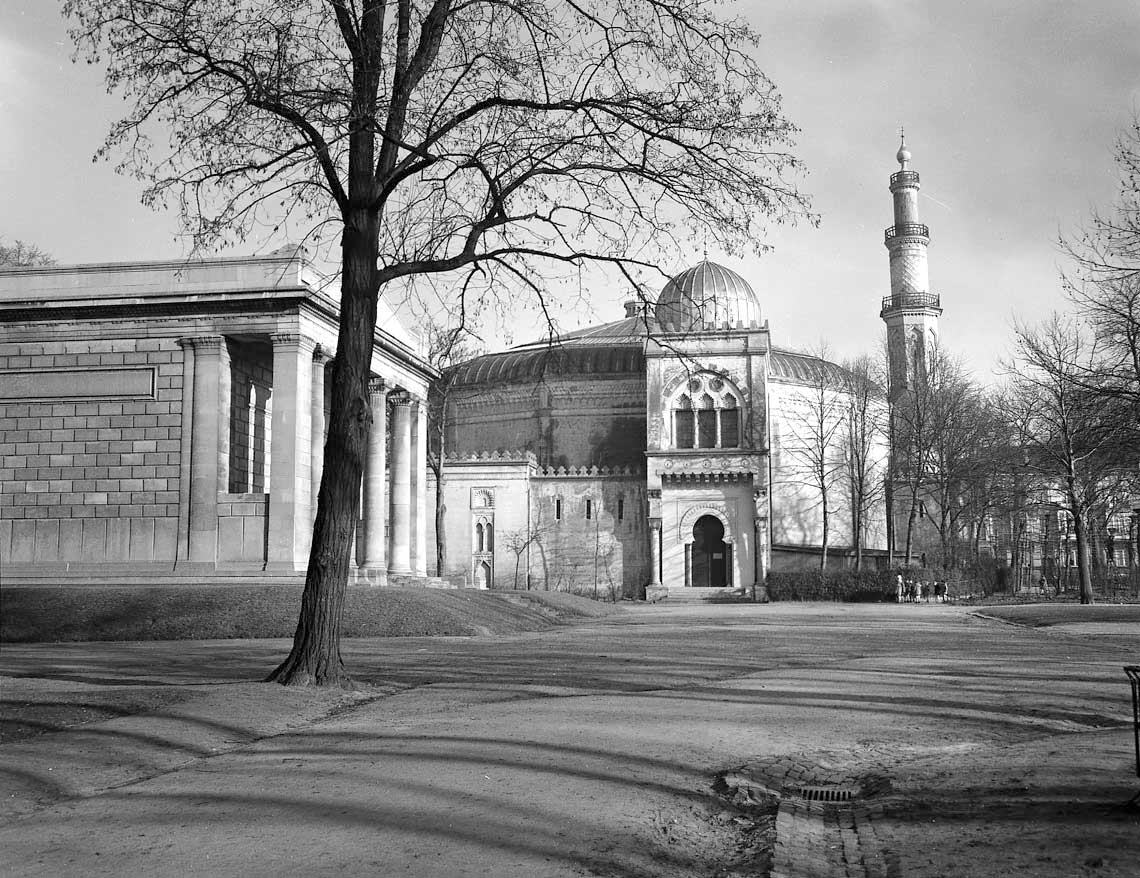
It was not until the early 1970s that a reaction began to take shape. Following an alarming 1972 report by Henri Fettweis of the Royal Museums of Fine Arts, emergency work was carried out to repair the broken door and seal the glass roof, among other things. The following year, at a time when Victor Horta’s works were gradually emerging from limbo, in particular following the outrage sparked by the demolition of the Maison du Peuple/Volkshuis (House of the People), the Royal Commission for Monuments and Sites began the process of having the pavilion listed.
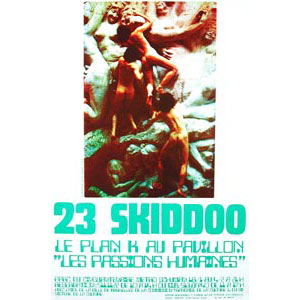
The rediscovery of the pavilion prompted discussions about its use. Following a suggestion by architect Alfred Ledent, a member of the Royal Commission for Monuments and Sites and author of the listing proposal (which was approved in 1976), in January and February 1977 the pavilion was leased to the avant-garde theatre company Plan K, whose actors even climbed on the relief as part of the show 23 Skiddoo. In the weeks that followed, the relief was given a free clean as part of a sponsorship campaign. This prompted the Régie des Bâtiments/Regie der Gebouwen (Belgian Buildings Agency) to arrange for the façades to be cleaned and some ad hoc repairs to be carried out.
These plans gained further momentum in July 1977, when the curators of the Royal Museums of Art and History agreed to fit out an exhibition room in the pavilion, which meant installing a power supply and heating. In addition to the initially planned cleaning, it was decided to replace the roof, which would be covered with a concrete slab inset with a new lantern, and to install a ramp along the right side of the building, to ensure disabled access to the premises. The existing entrance was to be replaced with a glass door, allowing the relief to be seen from the outside.
A visit to Belgium by King Khalid in May 1978 was to radically alter the pavilion’s fate. As the first European country to officially recognise Islam, Belgium had enjoyed excellent diplomatic relations with Saudi Arabia since the 1960s, and these became even closer following the 1973 oil crisis. On 9 May, King Khalid was in Brussels for the inauguration of the Islamic and Cultural Centre of Belgium, housed in the former Cairo Panorama building next to the pavilion, which had been let on a 99-year lease in 1969. Meanwhile, King Baudouin announced his decision that the cultural centre would be allowed to use the pavilion as a museum for the same 99-year period, “in order to facilitate the study and knowledge of Islamic culture by the Muslim community and its friends”. Significantly, perhaps, an economic cooperation agreement, which the two countries had been negotiating since 1974, was also on the agenda during the visit ...
The agreement formalising the King’s decision the following year not only set out the rights and obligations of each party but also provided for adaptation work to be carried out on the building. The relief – hardly compatible with the building’s new purpose – was to be dismantled and stored elsewhere. So it was that the restoration and adaptation work that had been planned (and for which the contract was awarded on 29 June 1978) was never carried out. In hindsight this was a blessing, especially with regard to the roof.
The contract to adapt the pavilion for its new purpose was awarded to the Tunisian architect Mongi Boubaker, who a few years earlier had overseen the transformation of the Cairo Panorama building into a mosque. The plans aimed to “give this pavilion a new exterior appearance in keeping with that of the newly renovated Islamic and Cultural Centre nearby”. The draft plans indicate a highly ambitious scheme that would have been hard to achieve given the size of the building. Spread over four levels, including a basement, the museum was to have an audiovisual space and two exhibition rooms as well as mechanical rooms required to operate the whole site, with vehicular access from the rear through a wide gate. Despite making extremely economical use of the available space, the architect realised that the pavilion would be too small for a conventional museum, and so planned to incorporate the new concept of a ‘video museum’. For the exterior of the building, the plans entailed adding Middle Eastern-style geometric decorations to the existing façades, with inscriptions placed inside the horizontal cartouches. The main façade would apparently have featured latticed windows. Alterations to the surroundings were also planned, including replacing the embankment with a series of geometric flowerbeds reminiscent of Middle Eastern gardens.

For the 1897 World’s Fair, Ernest Van Humbeeck designed a Middle Eastern-style building in the Parc du Cinquantenaire/Jubelpark to house a monumental canvas by Emile Wauters entitled Panorama du Caire (Cairo Panorama), after which the building was named. Following the exhibition, the building became an annexe of the Royal Museums of Decorative and Industrial Art, and in the early decades of the 20th century its condition gradually deteriorated, as did the painting inside. In 1969, the Belgian State transferred the structure, now in poor condition, to Belgium’s Muslim community, to be turned into a mosque and cultural centre. The canvas was taken down in 1971 and subsequently disappeared, but the building underwent a radical transformation by the architect Mongi Boubaker. The exterior of the rotunda was rendered and windows were added on three levels, reflecting the new three-storey division of the inside space. The ornamentation on the minaret was simplified and the building’s annexes replaced by a new concrete structure.
The plans for the redesigned pavilion were apparently not made public, but the mere possibility of splitting up what had been designed as a unified whole provoked an outcry in the cultural world, with the Royal Commission for Monuments and Sites, the Royal Academy of Archaeology of Belgium and the Advisory Committee on Arts and Crafts each voicing indignation in their own way. Given the huge diplomatic implications, the Belgian Buildings Agency turned a deaf ear to these protests. To enable the relief to be moved to an as yet undetermined location, the Minister of Public Works planned to split the listing order into two separate orders, which stoked further controversy.
This first wave of opposition having proved ineffective, the Horta Museum went a step further on 26 February 1980, submitting a request to the Council of State to annul the decision to break up the relief and pavilion. Despite this request (which would be rejected in September), work on dismantling the relief began in June 1980 and proceeded rather sloppily until the Governor of Brabant ordered its suspension on the grounds of the listing, whereupon the pavilion was sealed off to prevent any further work. The Euville limestone edging at the top of the relief, which was the only part to be dismantled, would not be replaced until the final restoration.
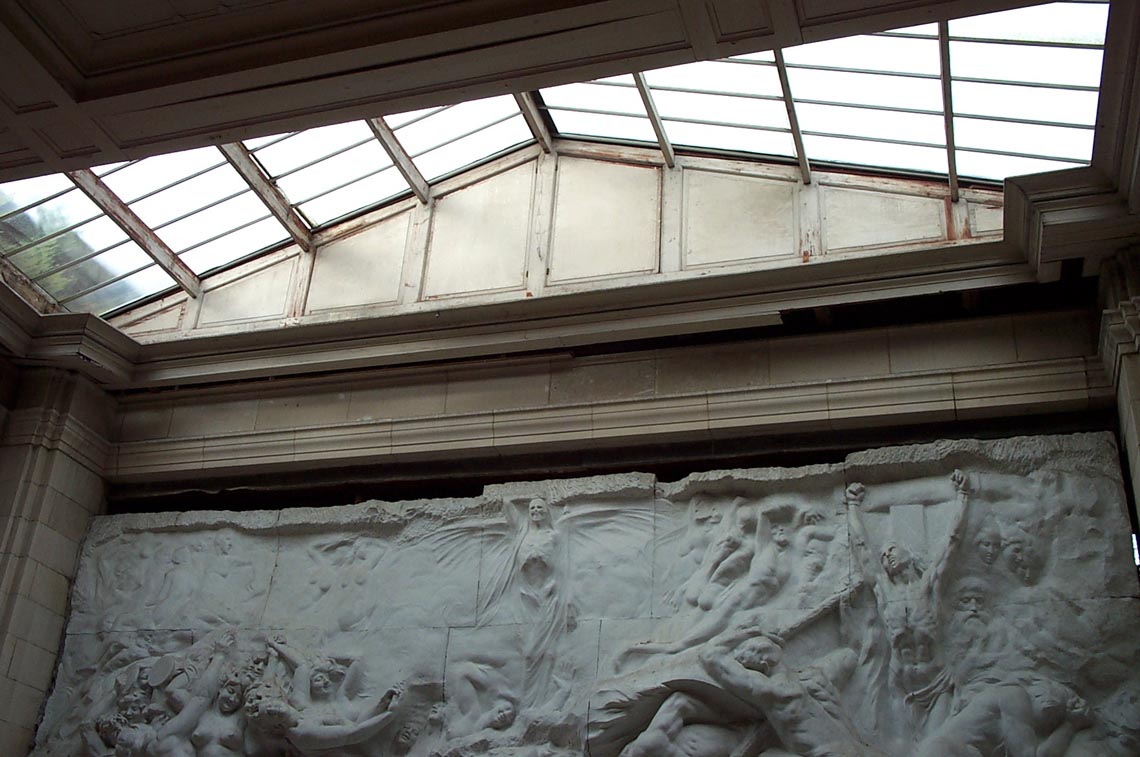
“The Royal Academy of Archaeology of Belgium, which included the Temple of Human Passions in its study programme, learnt of the threat facing the monument. At its meeting on 19 January 1980, it passed the following motion: “V. Horta’s building having been specifically designed to house the sculpture by Jef Lambeaux, it is vital that this work be preserved in its entirety. The Academy cautions against any solution which, by separating the bas-relief from the temple that houses it, would destroy forever the unified whole designed to show to its best advantage one of the largest monumental frescoes from the end of the last century.”
Motion of the Royal Academy of Archaeology of Belgium, 19 January 1980
With the dismantling work halted, an alternative solution emerged: following a suggestion by the Royal Academy of Belgium, the Secretary of State for the French Community proposed moving the building, including the relief, to another location in the park, thus freeing up the land next to the mosque for the construction of a museum. The plan was either to dismantle and reassemble the pavilion and relief, or to “move the building at the rate of a few centimetres a day”. However, the latter option was quickly deemed unviable as the ground near the entrance to the road tunnel was too weak. A working group made up of representatives from all the relevant government departments decided that the best option would be to build a museum on the site of the playground to the east of the mosque. This solution had the advantage of leaving the pavilion intact but it failed to win the backing of the Islamic and Cultural Centre, which still wanted the building to be relocated. This option was therefore put back on the table.
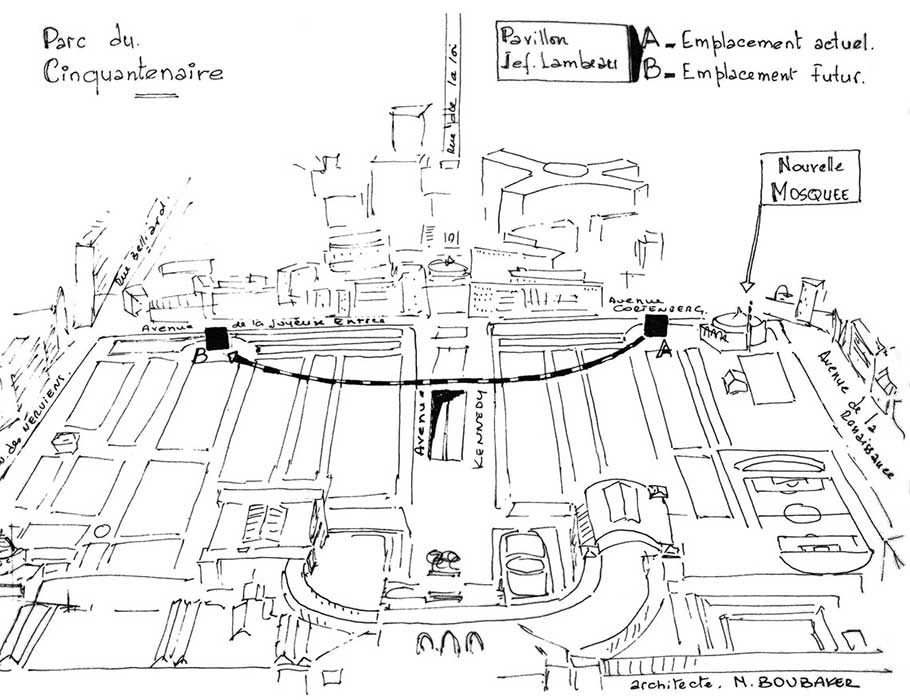
By the summer of 1981, the issue appeared close to being resolved. Firstly, a Royal Decree authorising the relocation was passed on 30 June 1981, and specifications were drawn up to dismantle the building and reassemble it on the lawn diagonally opposite its current location, in the south-western quarter of the park. Secondly, plans to build a museum to the east of the mosque had been approved by the Royal Commission for Monuments and Sites. However, a fresh round of protests soon undermined the whole project: cultural bodies complained that the operation could damage the monument and, above all, would set a dangerous precedent, while managers and users of the park were also unhappy. Over the following months, the site of the relocated pavilion and how it would be moved were the subject of further negotiations. Brussels City Council put an end to these in February 1982 by rejecting both the relocation of the pavilion – despite the earlier Royal Decree – and the construction of a new museum. While the Islamic and Cultural Centre initially refused to abandon its planned museum, a model of which was published in the press in February 1983, the Saudi ambassador eventually brought the dispute to an end. “Considering the endless obstacles encountered and keen to maintain the very good and amicable relations that happily exist between the Kingdom of Belgium and the Kingdom of Saudi Arabia,” he felt that it was necessary to “abandon, for the time being at least, all plans to establish this museum and to set the matter aside until another opportunity should arise.”
Throughout these protracted and ultimately unsuccessful negotiations, the condition of the pavilion, both exterior and interior, continued to deteriorate. An inventory drawn up for the Islamic and Cultural Centre in May 1980 described the building as “run-down”. The microclimate inside was also adversely affecting conservation of the relief. The building’s legal status complicated matters: while the lease agreement required the Islamic and Cultural Centre to maintain the property with due care, the fact that it could no longer use the building for its museum rendered this clause unsound. For its part, the Belgian Buildings Agency was no longer officially in charge of the pavilion and would not consider carrying out work there without initiating proceedings to recover it, for as long as the building remained closed, such work would be a sunk investment.
Until 1988, the stalemate persisted ... and the pavilion gradually seemed to fade into oblivion. The only evidence that its future was still under discussion comes in the form of plans drawn up in 1987 by the architects ARC: these would have seen the pavilion moved symmetrically to the southern half of the park and incorporated into a larger building designed to house the Royal Museums of Art and History’s collections of horse-drawn vehicles. The project, with an estimated price tag of 50 million Belgian francs, never got off the drawing board.
During the 1980s, amid a reappraisal and growing appreciation of Victor Horta’s work, the Pavilion of Human Passions, like the Maison du Peuple/Volkshuis and the Hôtel Aubecq, came to symbolise the mismanagement of Brussels’ architectural heritage. As simply terminating the lease agreement was out of the question for diplomatic reasons, the authorities for a time looked at amending the agreement to offer the Islamic and Cultural Centre an equivalent plot or building in lieu of the pavilion. Proposals were put forward in 1988, and again in 1996, but no agreement was reached.
Meanwhile, the pavilion was enjoying increasing popularity. Filmmaker Claude François made a short film about it in 1989, and two years later it provided the backdrop for several scenes in Harry Kümel’s film Eline Vere. Meanwhile, occasional tours of the pavilion were also being organised, which helped put it back in the public spotlight but did nothing to resolve the underlying problem.
It was not until the early 2000s that a restoration of the pavilion was given serious consideration again. The work eventually went ahead between 2012 and 2014 thanks to a collaboration between the Belgian Buildings Agency and Beliris, a federal agency responsible for carrying out construction and renovation projects in Brussels. Restoration of the relief followed soon afterwards: commissioned by the Royal Museums of Art and History, carried out in collaboration with the Royal Institute for Cultural Heritage (KIK-IRPA), and financed by the Baillet Latour Fund, it mainly involved removing dust from the entire work and repairing the joints between the marble blocks. In a bid to resolve the legal stalemate, on 1 April 2018 the minister responsible for the Belgian Buildings Agency decided to prematurely end the concession agreement between Saudi Arabia and the Belgian State.
As a result, the pavilion and its relief became part of the Royal Museums of Art and History and were opened to the public.
Preceded by several historical and technical studies and practical tests, the restoration of the pavilion took a minimalist approach, respecting as far as possible the layout and materials dating from the 1909 remodelling. The specifications and plans from the time as well as photos taken in 1910 and observations made in situ served as a basis for the research.
The façade restoration was limited to cleaning and preserving the natural look of the stone. The Euville limestone, used extensively for facing, had deteriorated due to loss of coherence and surface uplift. This inevitable process, inherent to the material and already observed in the early 1980s, was particularly pronounced on curved surfaces (columns), edging (strips) and carved features such as capitals. The latter, which were very eroded, affecting their readability, were repaired using restoration mortar and occasionally touched up with mineral pigments to help them blend in.

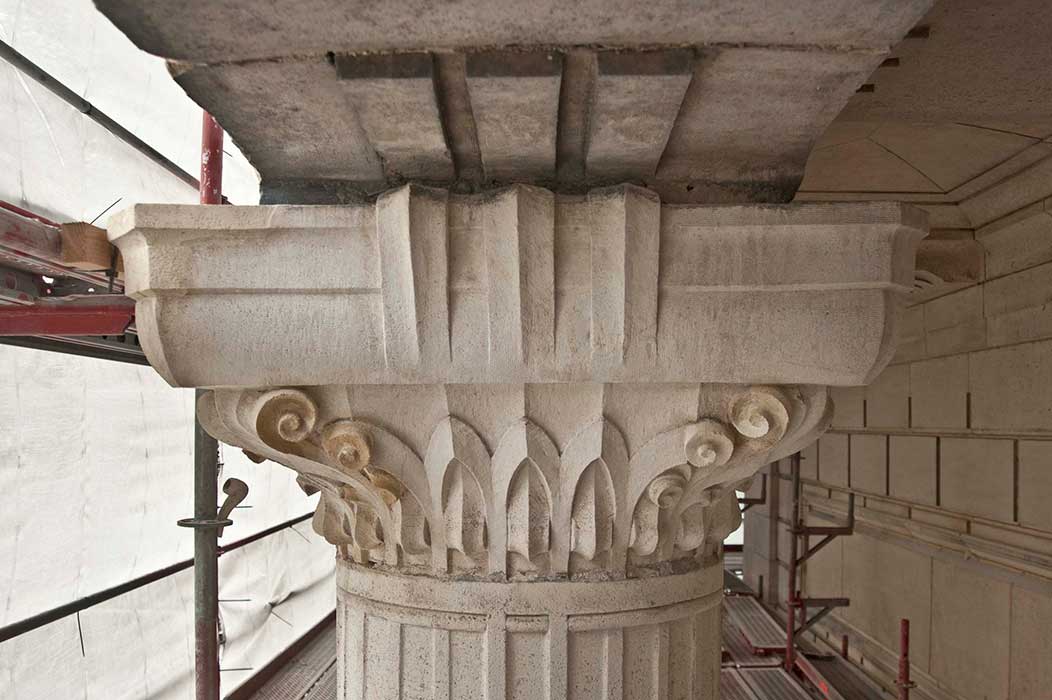
As the main cause of deterioration inside the pavilion was the poor condition of the roof, the zinc covering and gutters were replaced like for like. The glass roof – dating back to the repairs carried out in 1972 – was replaced by a structure similar in construction to the 1909 version, comprising metal T-profiles and acid-etched glass. The access to the roof via the mechanical room behind the relief was repaired, making it easier to maintain the roof in the future.
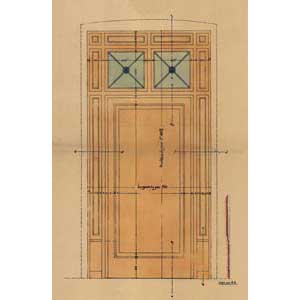
Despite the minimalist approach to the restoration, important decisions did need to be made about certain parts of the pavilion, including the doors.
Prior to the restoration work, the main entrance to the temple was a simple door made of Scots pine, protected by dark-green metal sheets. Studies soon revealed that these sheets had been fitted relatively recently, probably during the repairs undertaken in 1972. Removing the sheets exposed a layer of grey-green paint. While such a simple door might seem a strange choice for a building of this kind, and the grey-green paint suggests that it could have been a temporary imitation-bronze door pending the arrival of a more imposing alternative, it was decided, in the absence of any firm evidence (none of the surviving 1909 drawings featured details of this door), to restore the painted wooden door while preserving as much of the original as possible. The only minor difference from the original door is that it now has a pull handle and a peephole, allowing visitors to admire the relief when the pavilion is closed.
The rear entrance was a different matter: the existing door was a recent addition and in poor condition, and did not merit restoration. However, the 1909 plans did include a very detailed drawing of this door, and so the restorers made use of the opportunity to complete the pavilion according to Horta’s design. A new oak door was therefore fitted in keeping with the plans, even though such a door was probably never installed at the time.




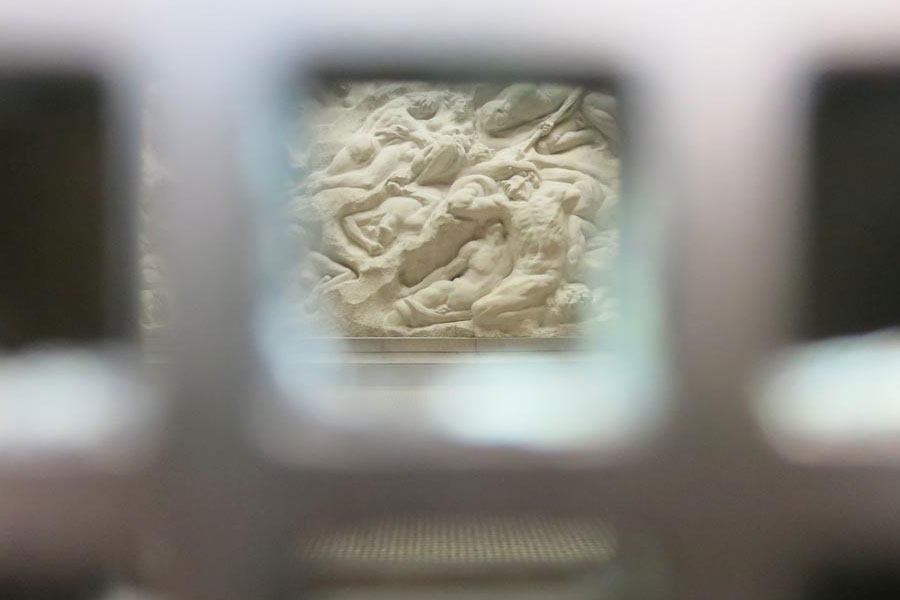
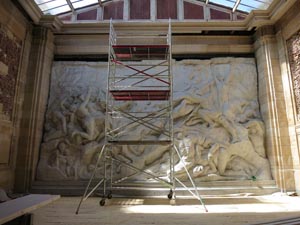
Inside, the facing was in relatively good condition and a light hand brushing and vacuuming was enough to refresh the surfaces. The more eroded parts, around the glass roof, were repaired using lime-based replacement mortar. The stonework above the relief, which had been taken down in 1980 ahead of the sculpture’s planned relocation, was finished off with Euville limestone. In a bid to visually enclose the space and direct the visitor’s gaze towards the relief, an awning was placed in the opening in the ceiling leading to the glass roof. This also had the advantage of reducing the shadows cast by the roof structure onto the relief while also, thanks to the acid-etched glass, ensuring diffuse natural lighting for the sculpture.
The floor, comprising a mosaic of Carrara (white), Griotte (red) and Verona (orange) marbles, was in very good condition, so was just lightly sanded and cleaned.
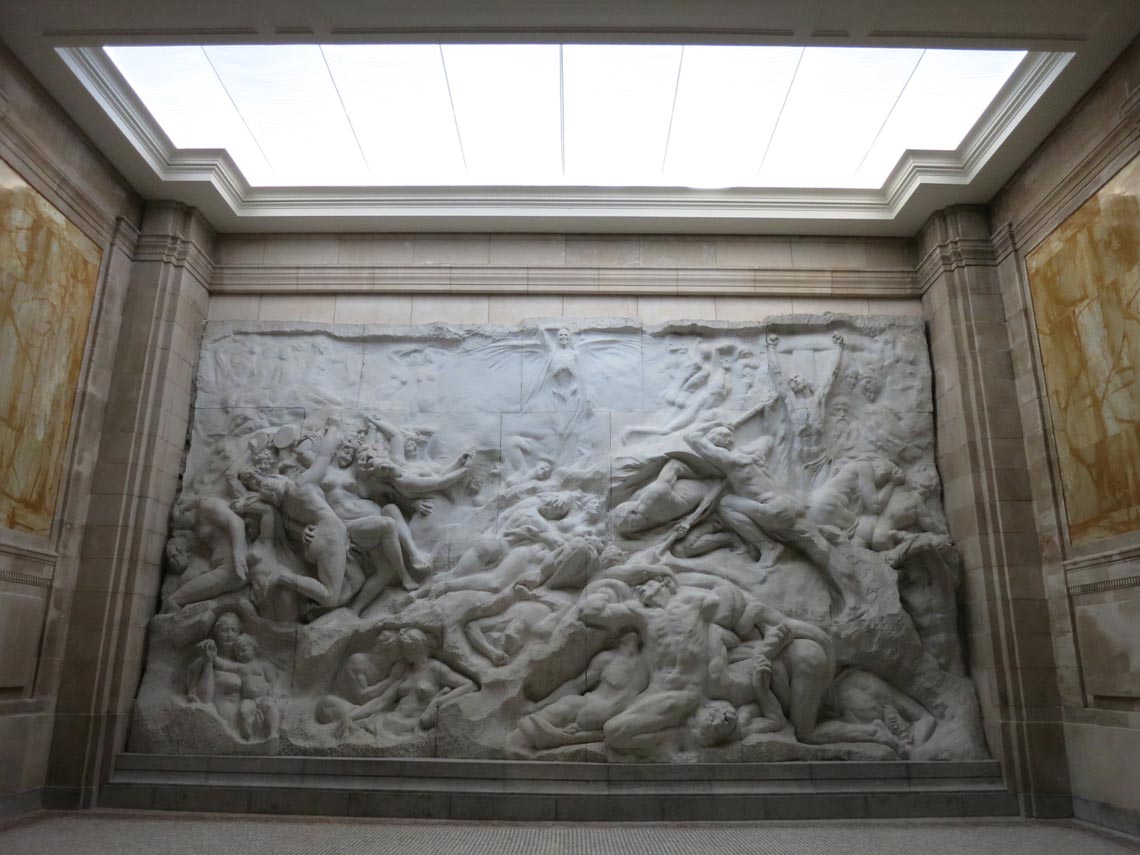
The most challenging aspect of the interior work was dealing with the decorative panels of yellow Siena marble adorning the walls. Fitted when work was carried out in 1909, these decorative elements consisted of an assembly of several marble slabs 3 cm thick, placed one on top of the other and attached to the masonry using plaster. Problems with water ingress and possibly knocks sustained over the years meant that the slabs were no longer correctly aligned. In addition, one panel had fallen to the ground in 1972 and shattered. When a second one fell in 2012, an urgent survey of the panels was carried out and they were all taken down and put into storage. To reconstruct the two missing panels, it was decided, after much research and testing had failed to find a matching material, to divide some of the existing slabs by splitting them lengthways, thus perfectly preserving the harmony of colour and pattern. This extremely delicate operation was carried out by a Carrara marble works, which was found to be the most competent at the job following a full-scale test. As the resulting panels were thinner than the originals, they were reinforced with a backing plate. All the marble was then cleaned and restored, before being replaced using metal fasteners anchored in the supporting masonry. Finally, microcrystalline wax was applied to complete the restoration.

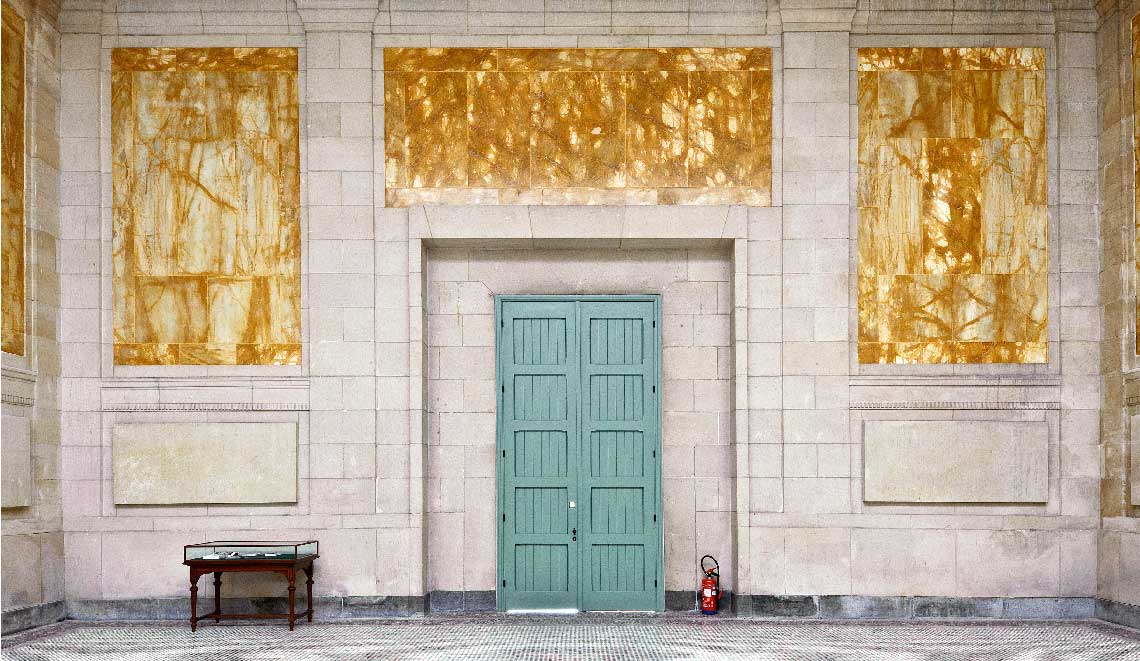
Close examination of old photographs reveals that the steps up the mound on which the pavilion sits underwent several changes over the years. Pictures of the pavilion after its remodelling in 1909 show that these steps were originally the same width as the temple steps. On closer inspection, they appear to be made of wood. This is borne out by a 1911 press article and explains why they did not last very long. The photo of the pavilion from 1925 shows that they had been replaced by a narrower set of steps, but it is impossible to tell what these were made of. Before the most recent restoration, the pavilion was accessed by a narrow brick staircase. In keeping with the decision to restore the 1909 features where possible, these stairs were replaced by a new set of wide steps, made of Petit Granit limestone rather than wood, for obvious reasons of durability. The finish of the new landing slabs at the top of these steps is a contemporary mechanical take on the mosaic-style chiselled carving found on the blue limestone floor of the pronaos.
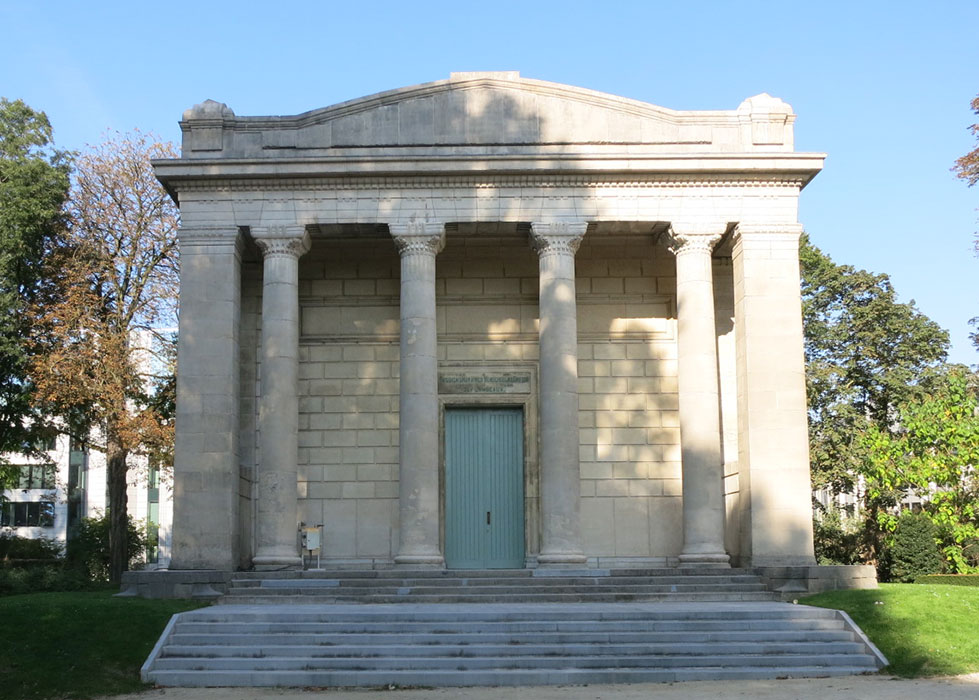
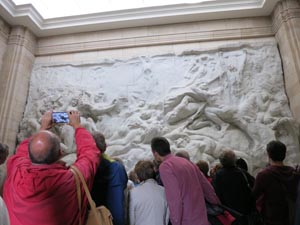
Initially seen as merely a showcase for a major work of art and an early career boost for a promising young architect, the Pavilion of Human Passions, though the result of compromises, is now considered a key milestone in the formation of the architectural personality of one of the masters of Art Nouveau. And yet, after a long (20 years!) and arduous inception, the pavilion and the monumental relief were to languish in obscurity for much of the 20th century, only re-emerging when they were set to be dismantled. The listing of the building and its contents in 1976 may have prevented their irreversible mutilation, but it was not until a century after its inauguration that the pavilion underwent its first restoration, which a long period of neglect had made all too necessary.
A story with a happy ending, yes... but one that should make us think twice before hastily condemning or altering recent works that will become the heritage of the future, and in which the relationship between art and architecture often plays a pivotal role.
14 Jan. 1852, Birth of Jef Lambeaux
6 Jan. 1861, Birth of Victor Horta
1883, Jef Lambeaux travels to Italy to study 16th- and 17th-century sculpture
1884, Victor Horta wins the Godecharle Prize and draws up plans for the restoration of a temple in Vienne (France)
1886, Jef Lambeaux begins work on the design for his relief The Human Passions
1886 > 1889, Drawing (carton), clay model and bronze version
Autumn 1888, Press rumours of a tacit commissioning of the relief by the Belgian State
1889, Drawing of The Human Passions displayed at Lambeaux’s studio in Saint-Gilles and at the Ghent Salon
1889-1897, Sporadic controversy in the press
8 August 1890, Contract between the Belgian State, Jef Lambeaux and Victor Horta to create the relief and pavilion
1891, Start of construction work on the pavilion in the Parc du Cinquantenaire/Jubelpark
1894, Unveiling of the final composition of the relief (in plaster) in the pavilion, then still under construction
1897, Brussels World’s Fair. Neither the relief nor the pavilion are ready
1899, The marble relief is unveiled to the public, but four days later a wooden barricade conceals it from view
1899-1900, A plaster cast of the marble relief is exhibited in a number of European cities
1904-1905, Lighting tests on the relief in the pavilion
1906, Horta proposes a modified version of the pavilion (never implemented)
5 June 1908, Death of Jef Lambeaux
1909, Final plans for the pavilion drawn up by the Civic Buildings Department
1910, Completion of work, pavilion opened without ceremony
1911, Pavilion placed under the responsibility of the Fine Arts Department
1910-1939, Pavilion opened only very occasionally to the public
1939-1970s Pavilion closed to the public
8 Sept. 1947, Death of Victor Horta
1970s, ‘Rediscovery’ of the pavilion
1976, Pavilion listed as a protected monument
1977-1978, Plans drawn up to renovate and adapt the pavilion (never implemented)
1978, Pavilion leased to the Islamic and Cultural Centre of Belgium under a concession agreement
1979, Plans drawn up for the King Khalid Islamic Museum (never implemented)
1981-1982, Plans drawn up to move the relief and pavilion (never implemented)
1987, Plans drawn up to incorporate the relief and pavilion into a horse-drawn vehicle museum (never implemented)
2000, Pavilion opened regularly by the Royal Museums of Art and History
2012-2014, Restoration of the pavilion and relief
2018, Concession agreement with the Islamic and Cultural Centre ended prematurely
DE CALATAŸ, F., «Les «Passions Humaines» de Jef Lambeaux: un essai d’interprétation», in Bulletin des Musées Royaux d’Art et d’Histoire, tome 60, 1989, p. 269-289.
DIERKENS-AUBRY, F., «Victor Horta, architecte de monuments civils et funéraires», in Bulletin de la Commission royale des Monuments et des Sites, tome XIII, 1986, p. 37-101.
DULIÈRE, C., «Le pavillon des Passions humaines au Parc du Cinquantenaire», in Revue belge d’archéologie et d’histoire de l’art, tome XLVIII, 1979, p. 85-97.
FIERENS-GEVAERT, H, «Jef Lambeaux et le Monument des Passions Humaines», in Art et Décoration, 3e année, n° 11, novembre 1899, p. 129-133.
FORNARI, B., Jef Lambeaux et les Passions Humaines, Brussels, Fondation pour la Protection des Monuments et de Sites, 1989.
GOSLAR, M., Victor Horta 1861-1974. L’homme, l’architecte, l’Art nouveau, Fonds Mercator, 2012.
GUISSET, J., «À propos des «Passions Humaines» de Jef Lambeaux», in Bulletin des Musées Royaux d’Art et d’Histoire, tome 65, 1994, p. 335-339.
HAERENS, Jo, «Jef Lambeaux en het reliëf der Menselijke Passies. Een historisch overzicht», in Bulletin van de Koninklijke Musea voor Kunst en Geschiedenis, tome 53, n° 1, 1982, p. 89-105.
HORTA, V., Mémoires, texte établi, annoté et introduit par Cécile Dulière, L. Thiriar Laruelle et P. Laruelle, Communauté française de Belgique, 1985.
S. [OLVAY], L., «Les Passions Humaines, de Jef Lambeaux», in Bruxelles-Exposition, s.l., s.e., 1897, p. 64-68.
TEIRLINCK, H., «Jef Lambeaux», in L’Art Flamand et Hollandais (numéro spécial), 6e année, n° 5, 1909, p. 149-167.
Writing and iconographic research
Werner Adriaenssens, André Demesmaeker, Claudine Houbart
Support committee
Julie Coppens, Paula Dumont, Murielle Lesecque – urban.brussels
Barbara Van der Wee
Coordination
Okke Bogaerts, Julie Coppens, Paula Dumont, Valérie Orban – urban.brussels
Translation
Linguanet
Proofreading
Judith Flush (GB)
Photographic credits (abbreviations)
AAM Archives d’Architecture Moderne
AHM Archives of the Horta Museum, Saint-Gilles
ACB Archives of the City of Brussels
CIVA Centre International pour la Ville, l’Architecture et le Paysage
KBR Royal Library of Belgium
KIK-IRPA Koninklijk Instituut voor het Kunstpatrimonium / Institut royal du Patrimoine artistique
KMSKA Koninklijk Museum voor Schone Kunsten Antwerpen
RMAH Royal Museums of Art and History
RMFAB Royal Museums of Fine Arts of Belgium
MSK Museum voor Schone Kunsten Gent
SAB State Archives of Belgium
Graphics
La Page
Responsible publisher
Bety Waknine, General Director, urban.brussels
(Regional Public Service of Brussels, Urbanism and Heritage) – Mont des Arts/Kunstberg 10-13 – 1000 Brussels
Digital ISBN
978-2-87584-202-2
Legal deposit of the book
D/2021/6860/005 – ISBN 978-2-87584-194-0
Cover picture:
The Pavilion of Human Passions, arch. Victor Horta. Interior view after restauration, 2014.
(© Belgian Buildings Agency).
Copyright © Urban Brussels 2021